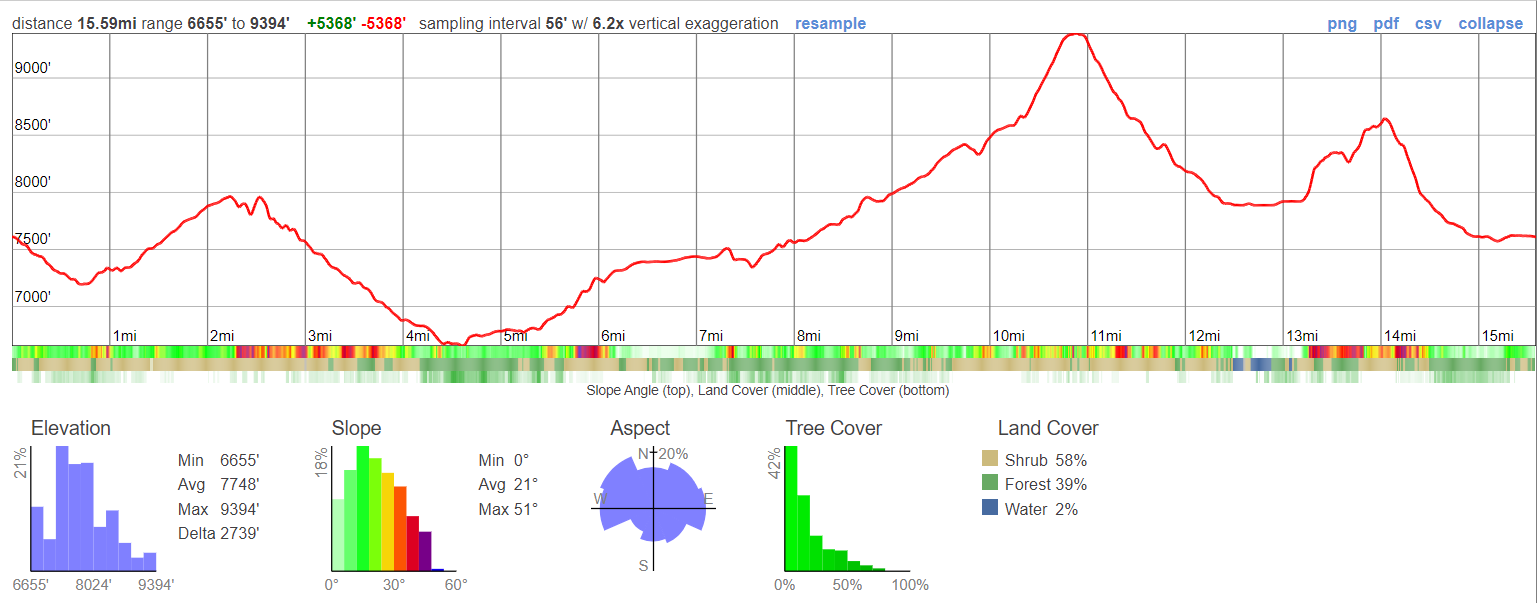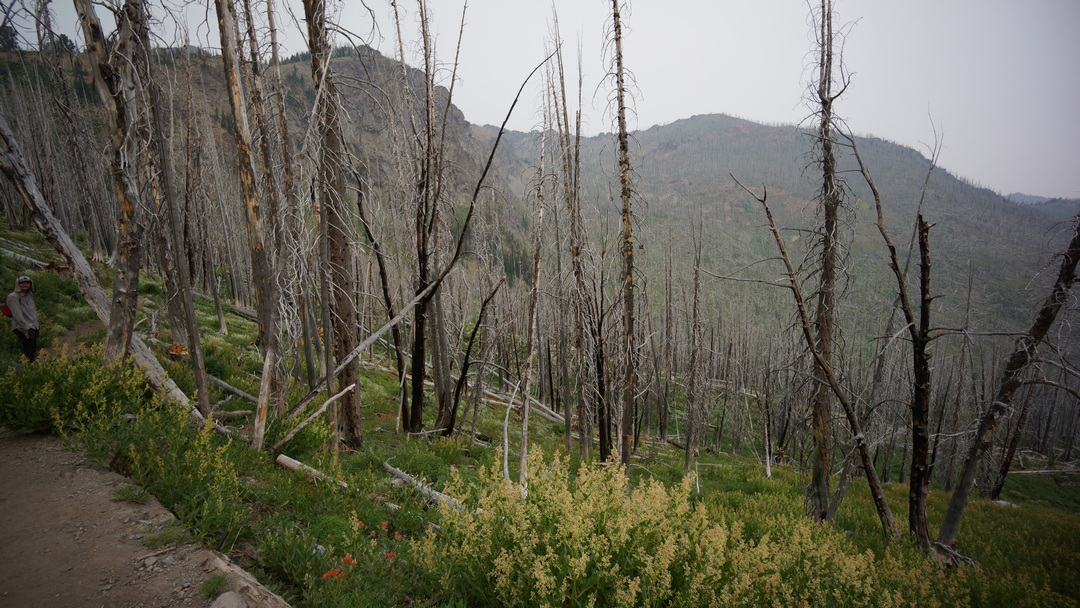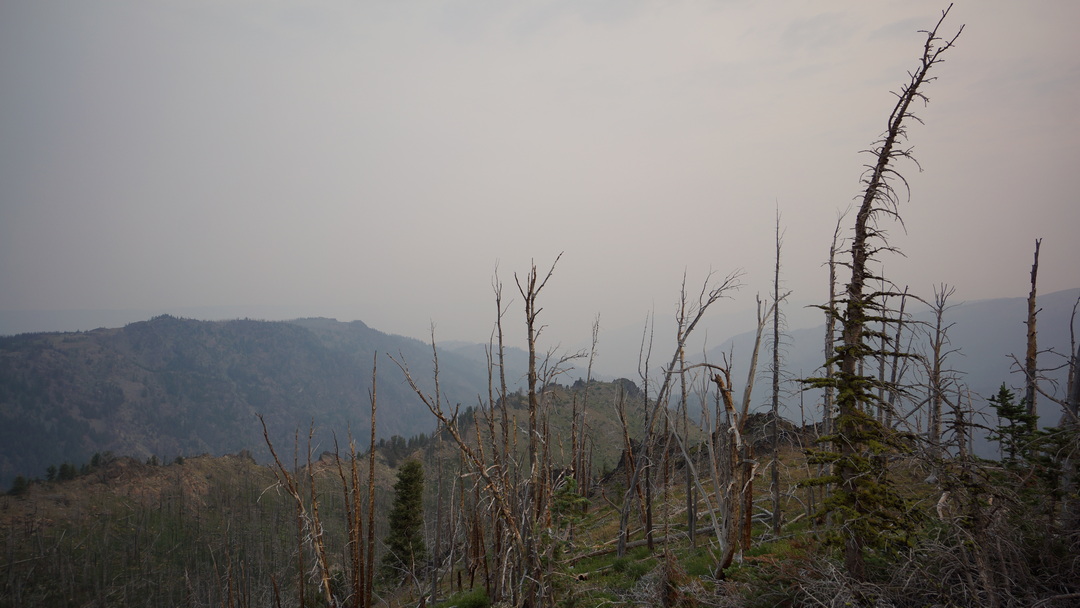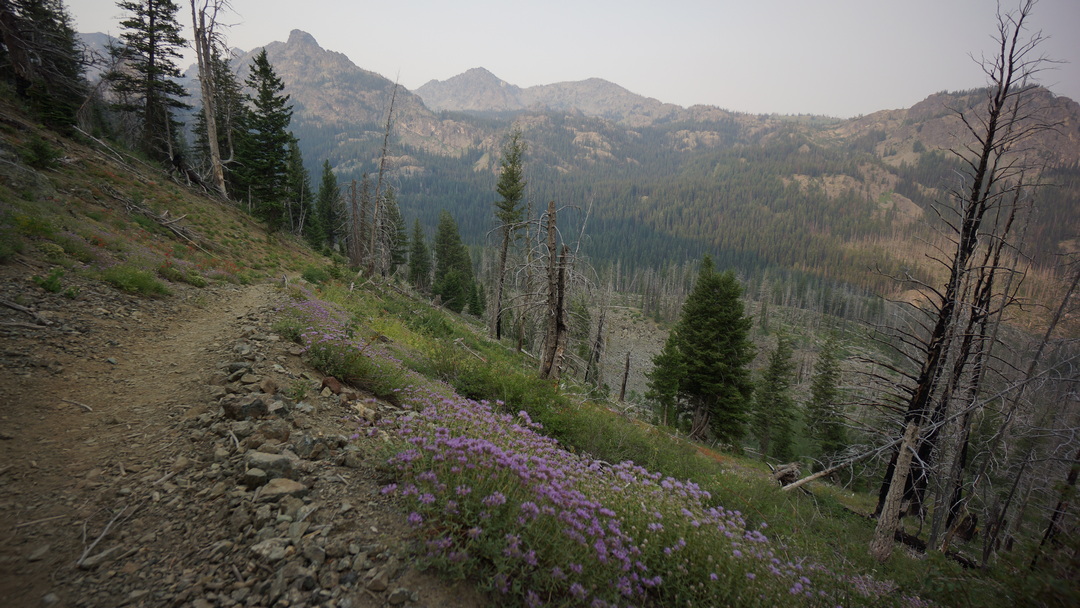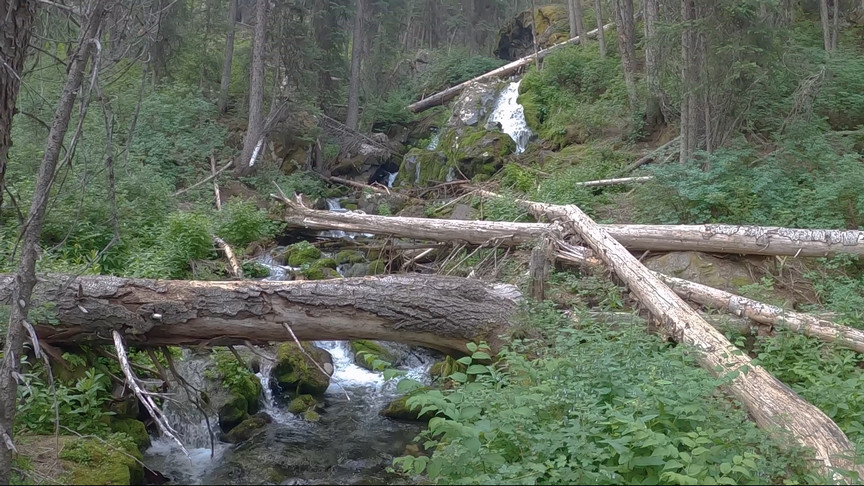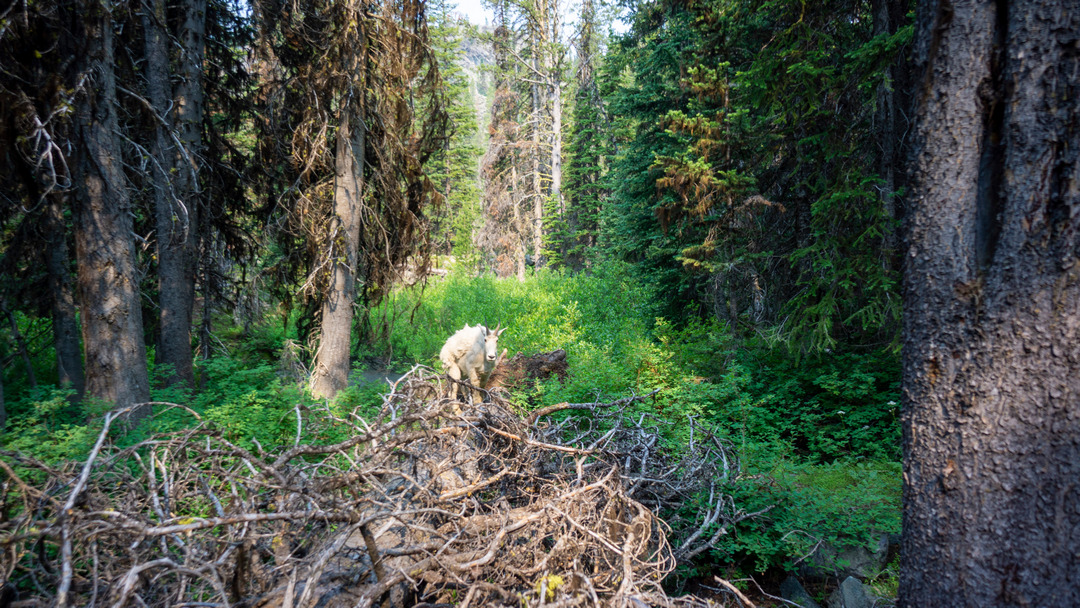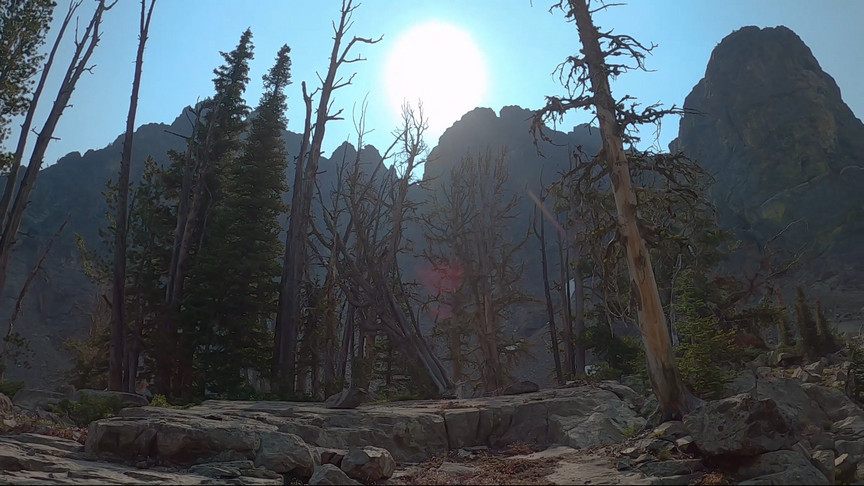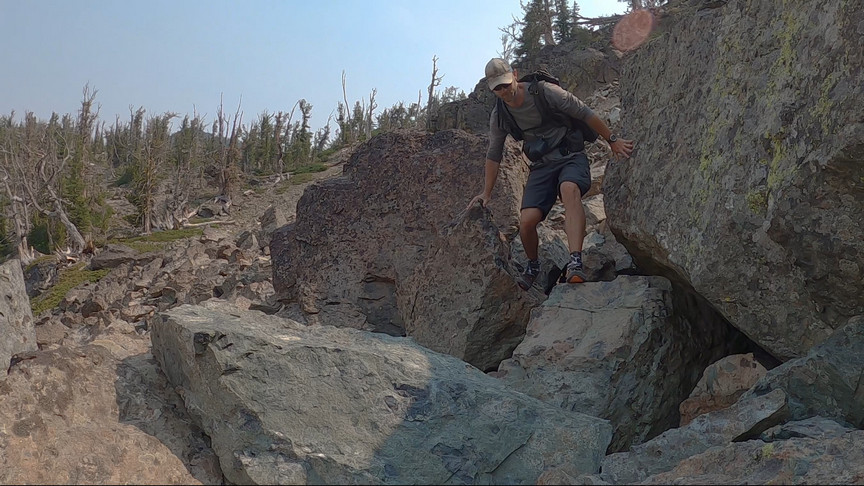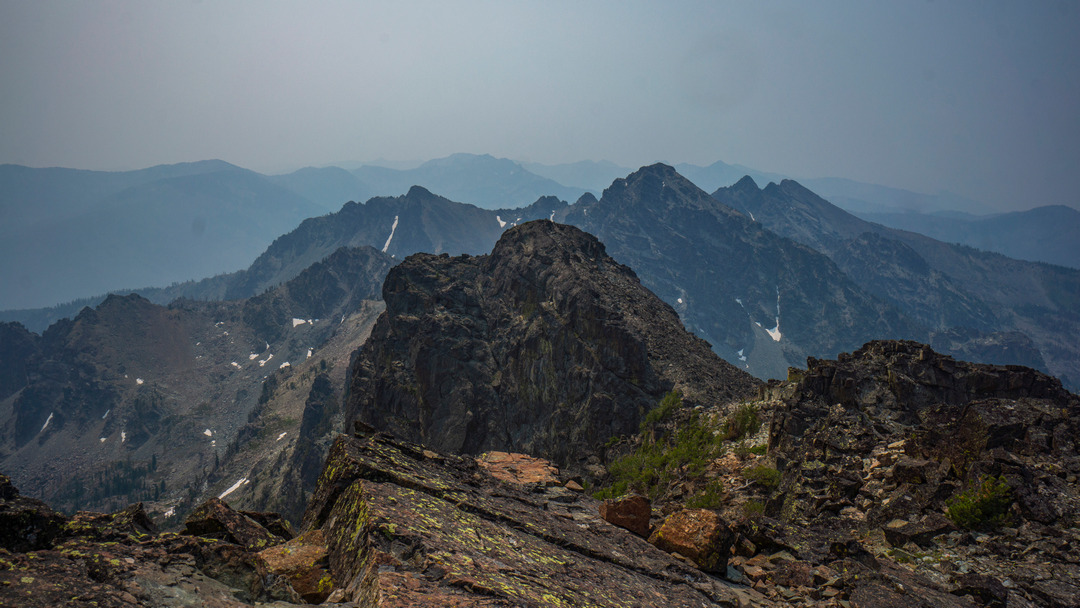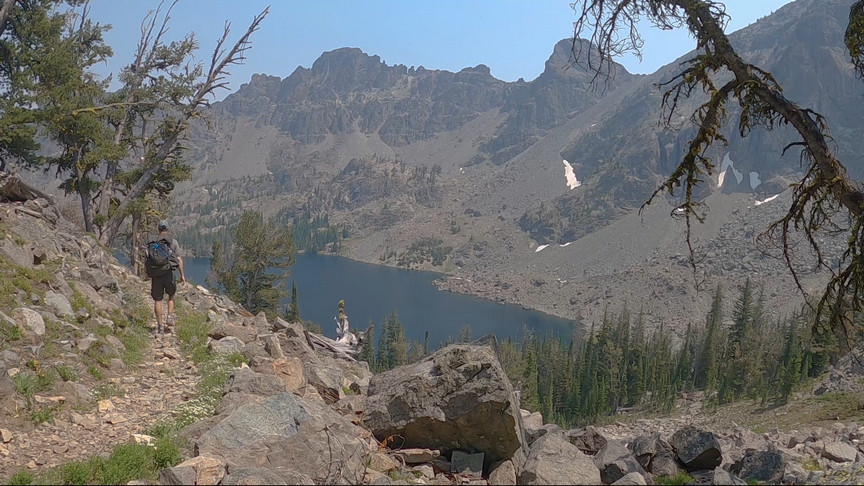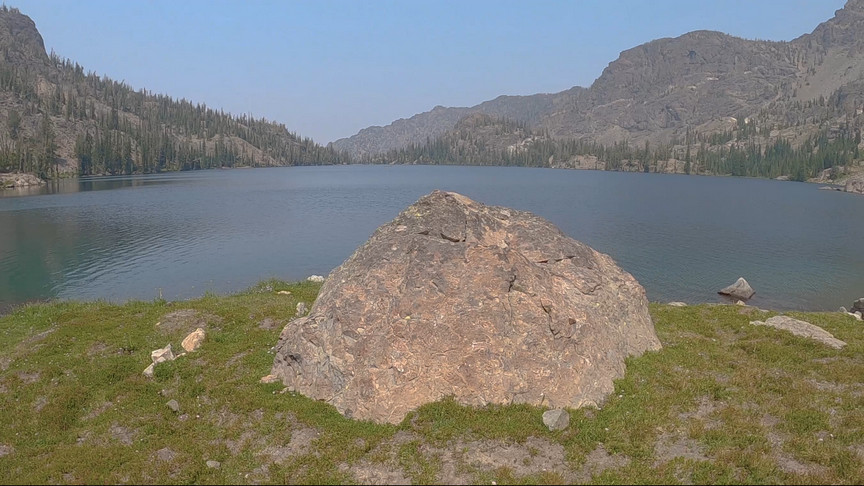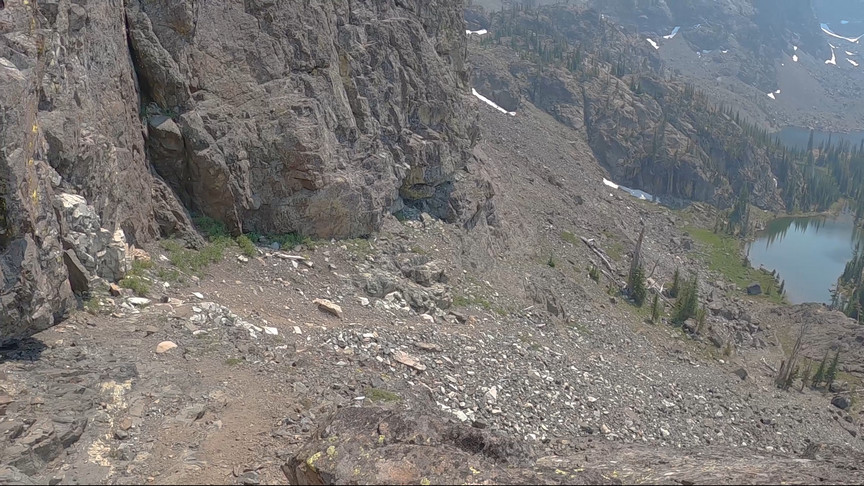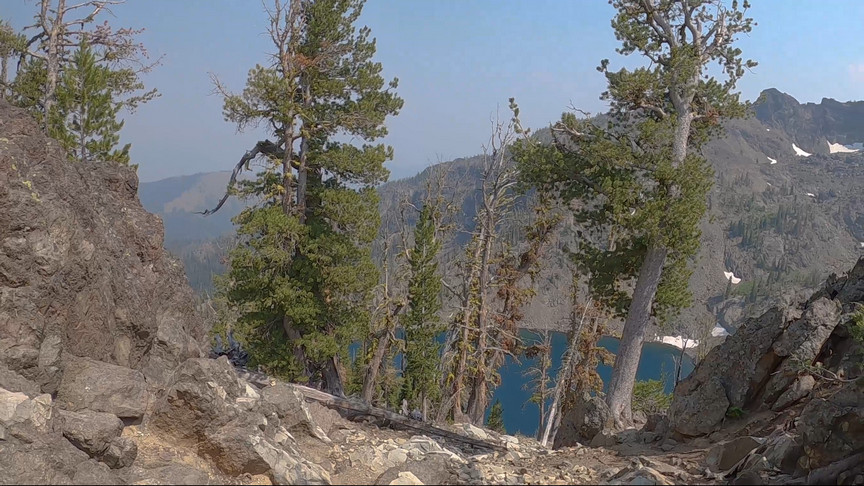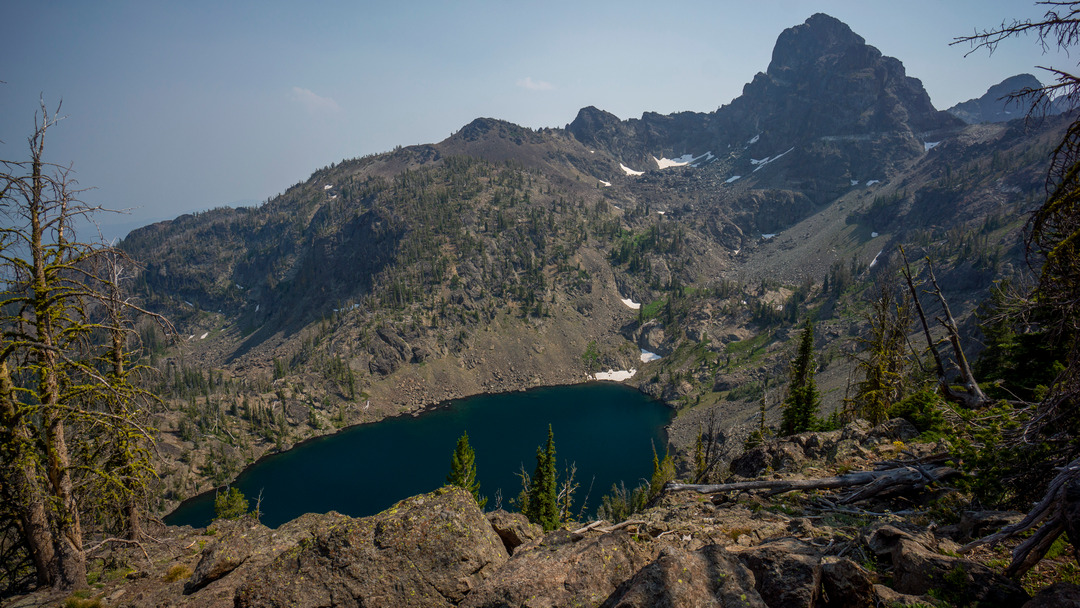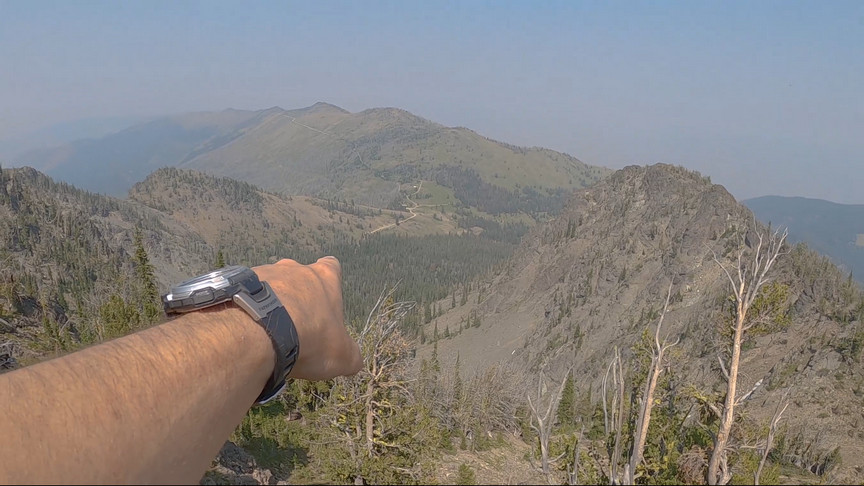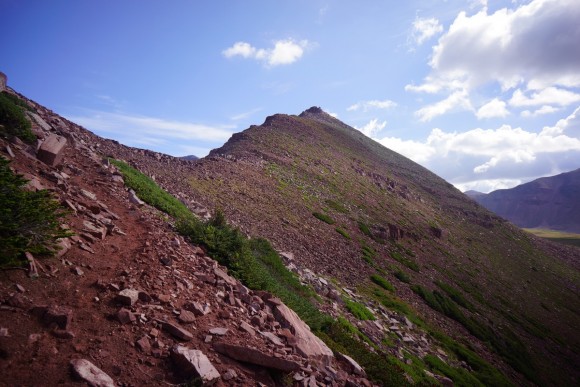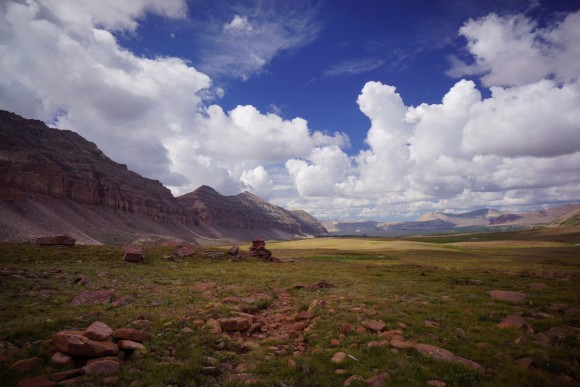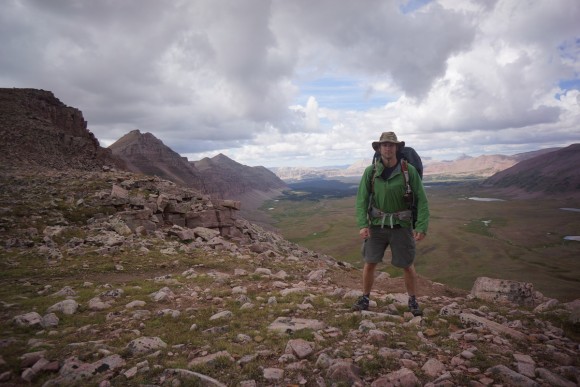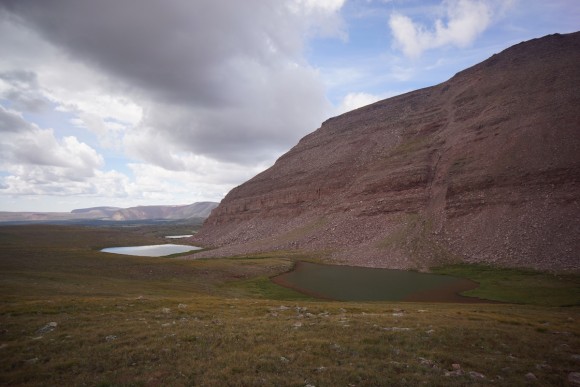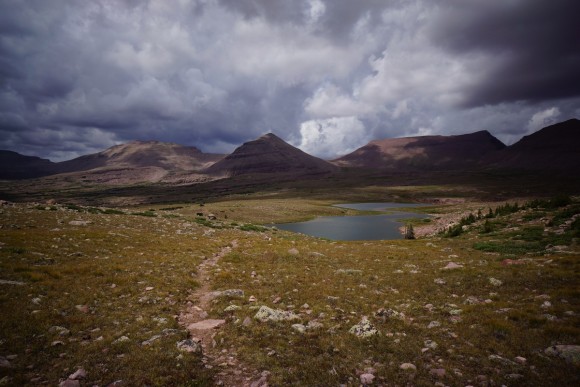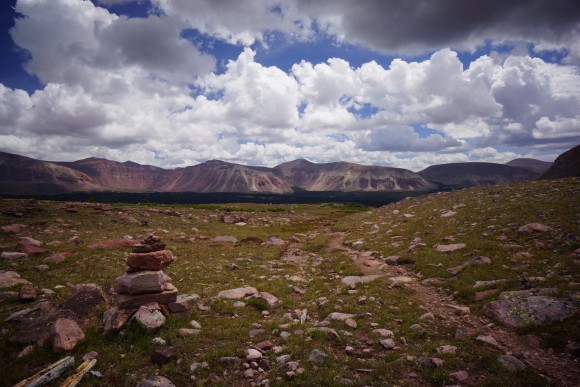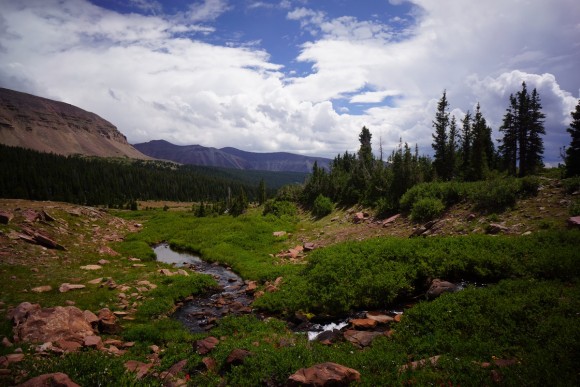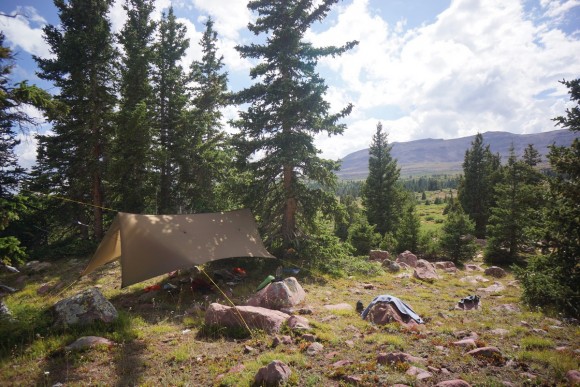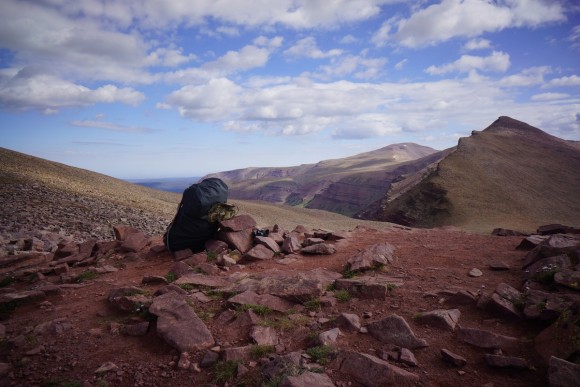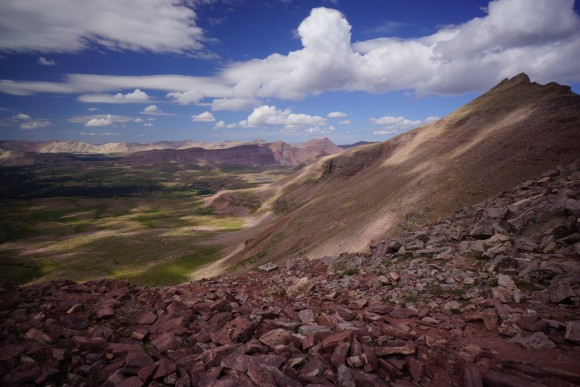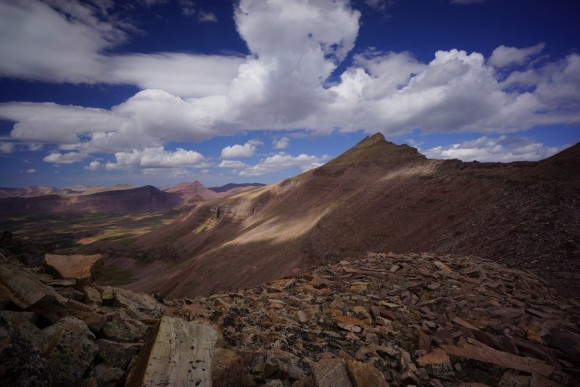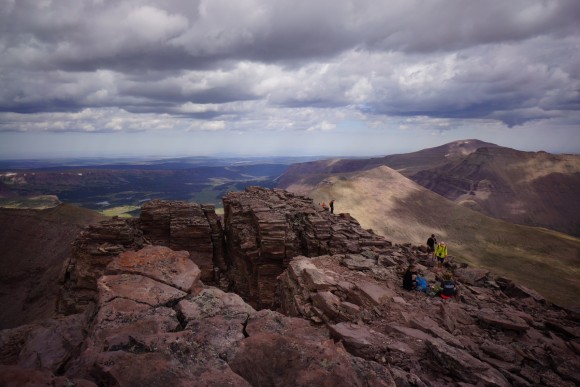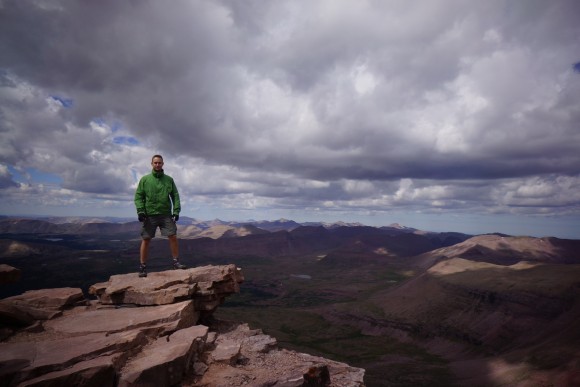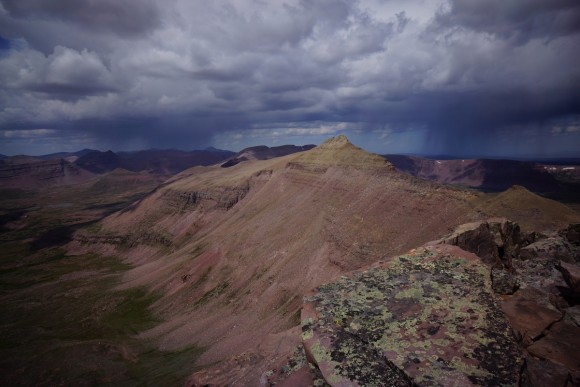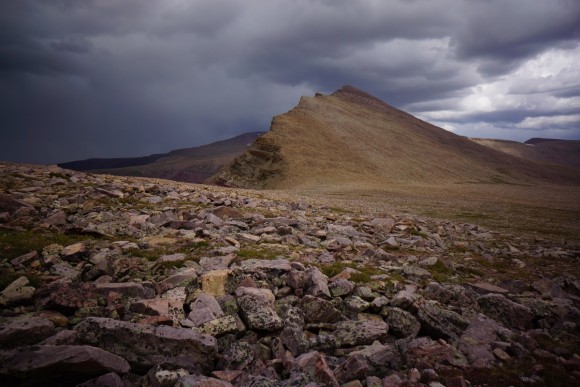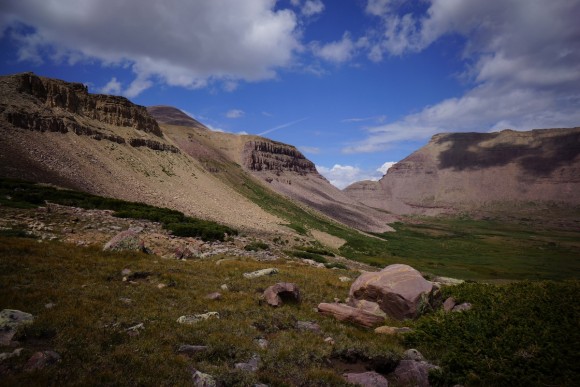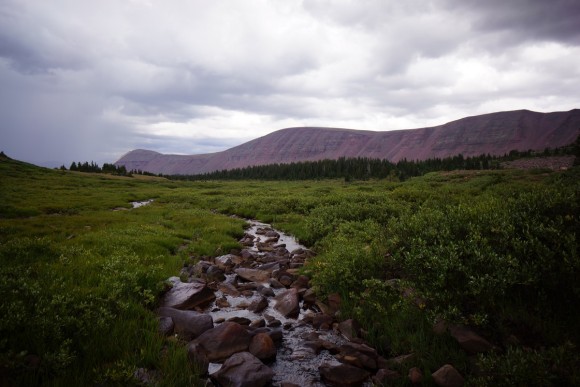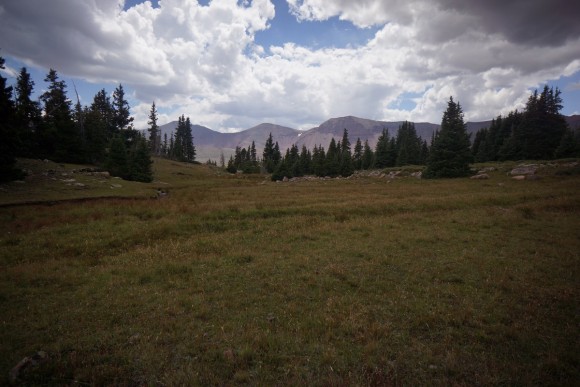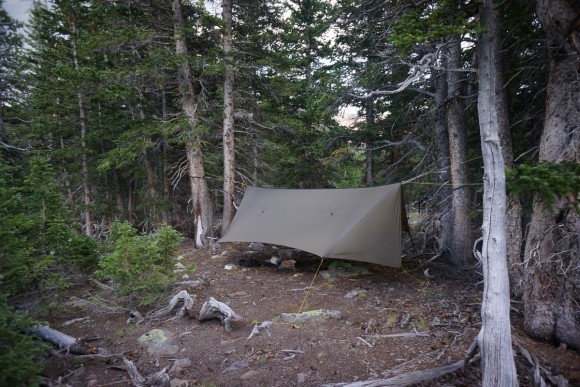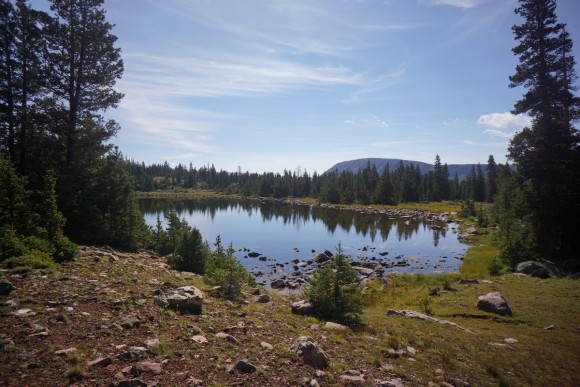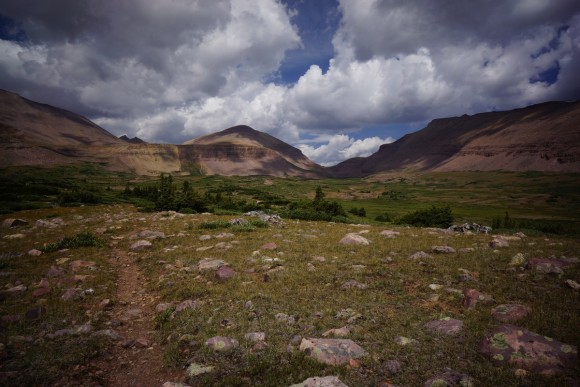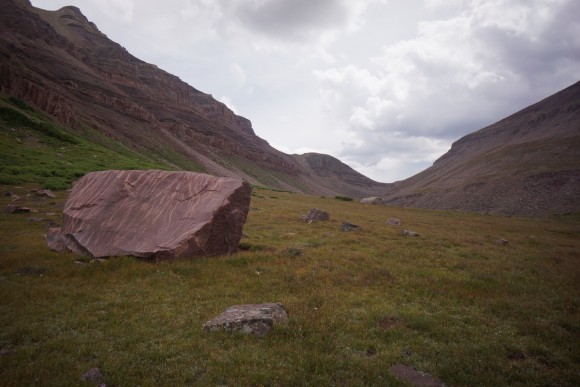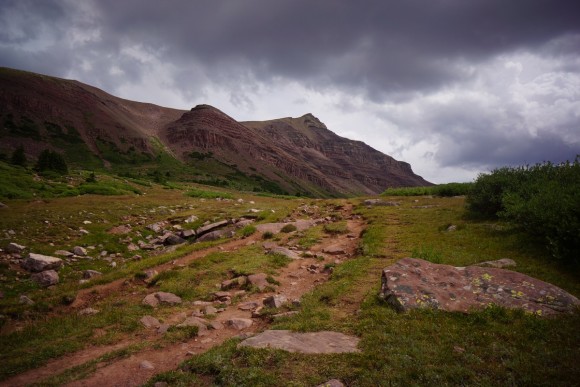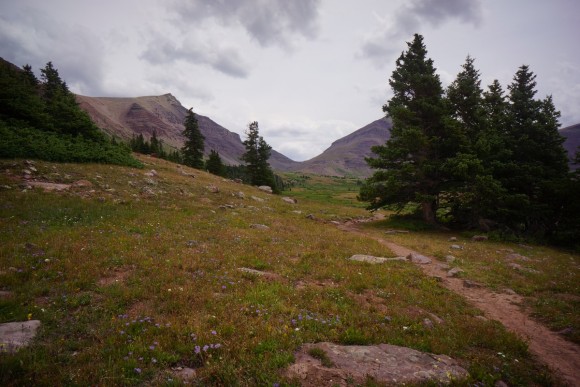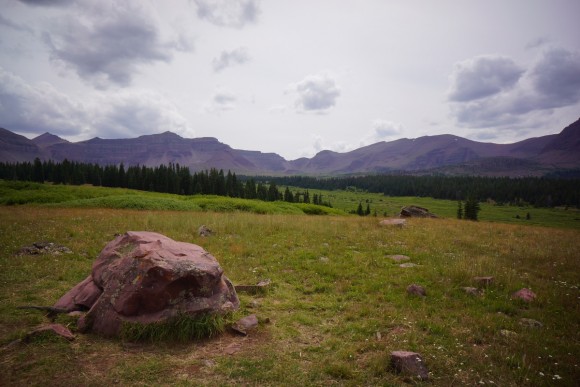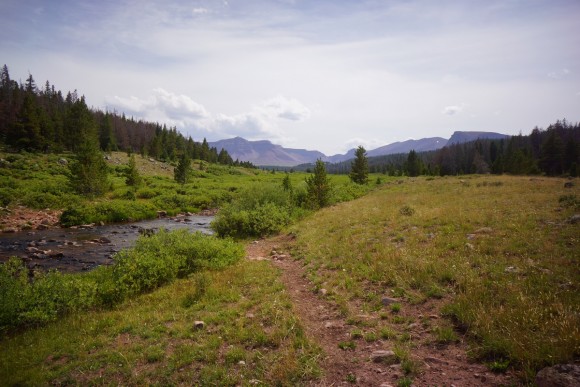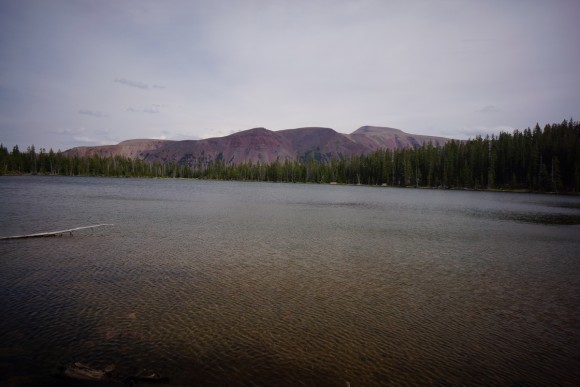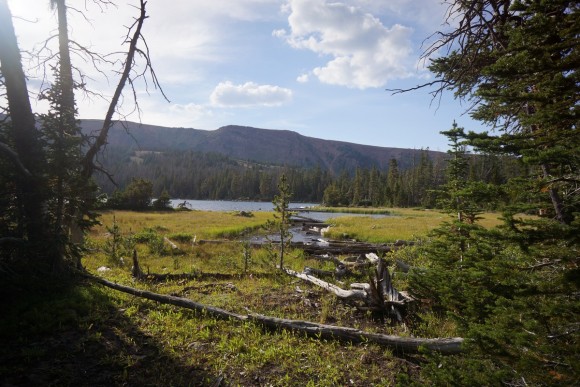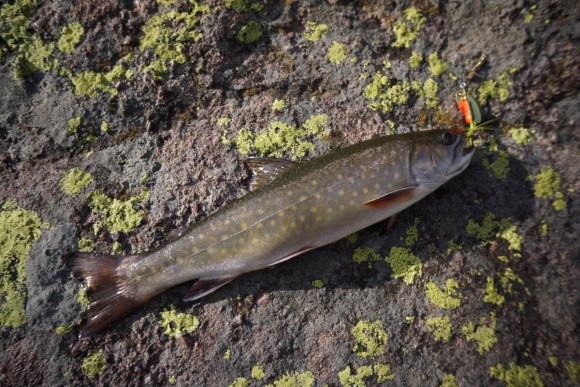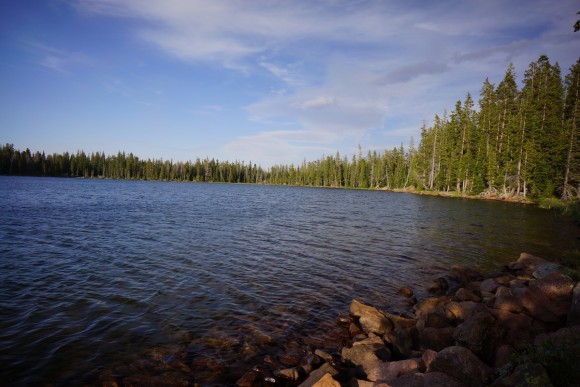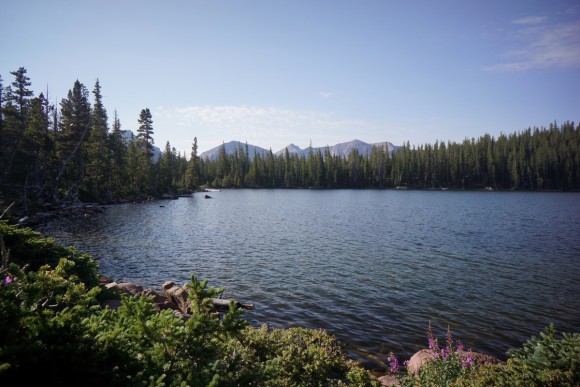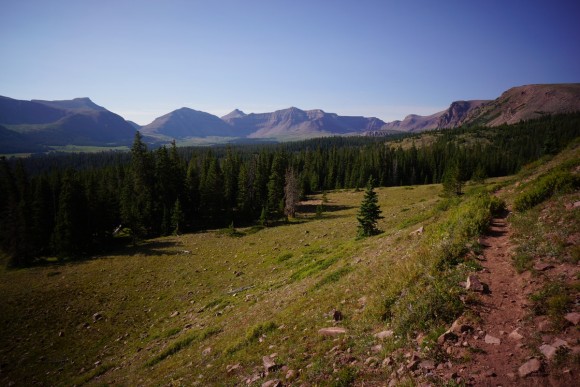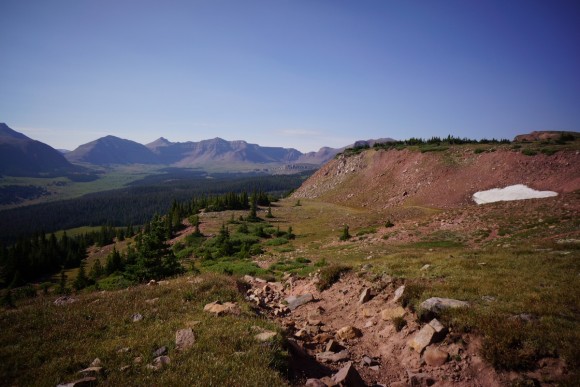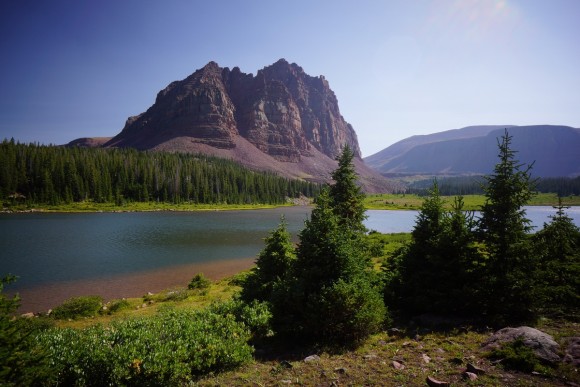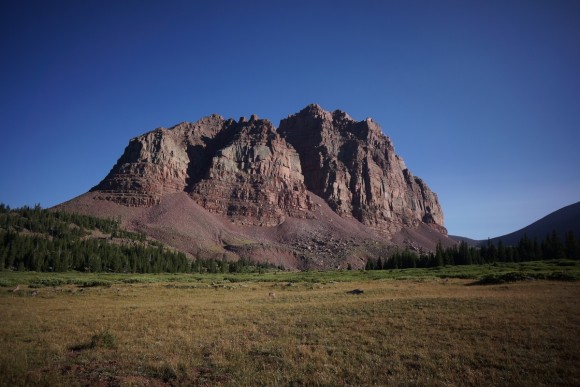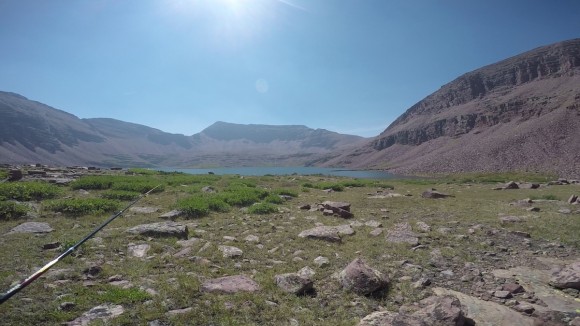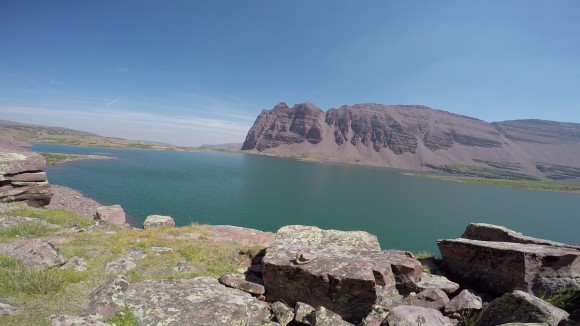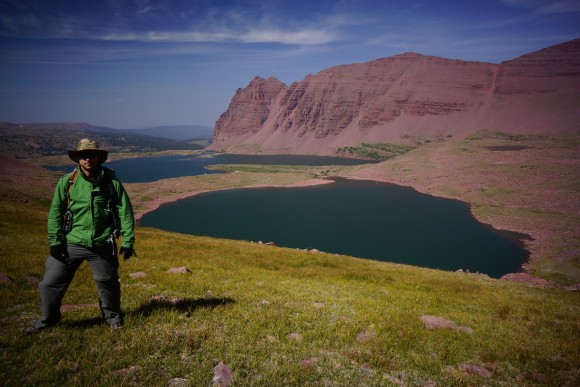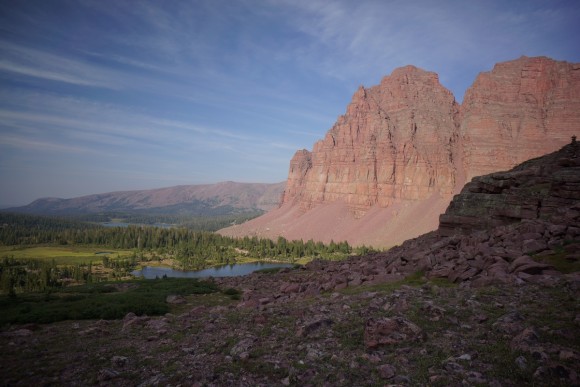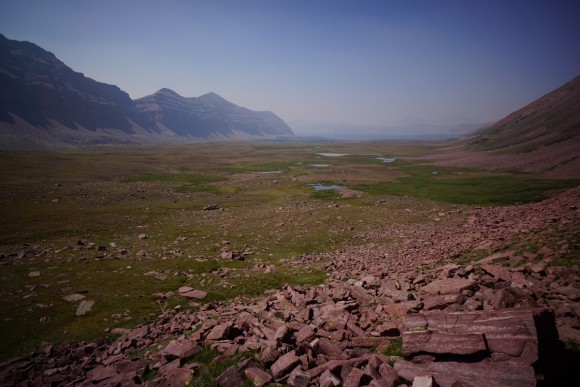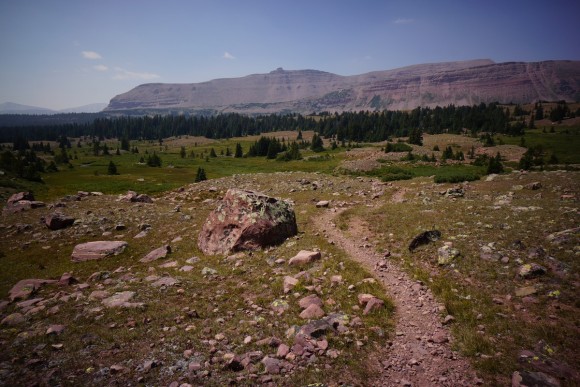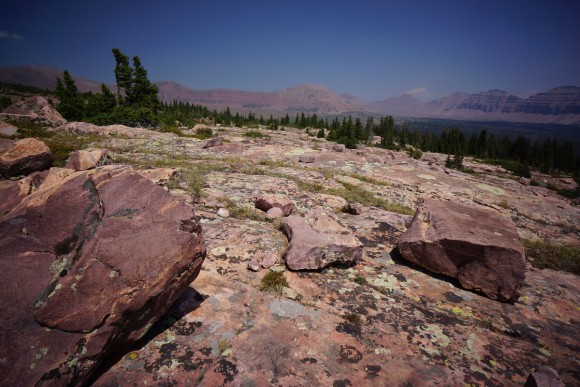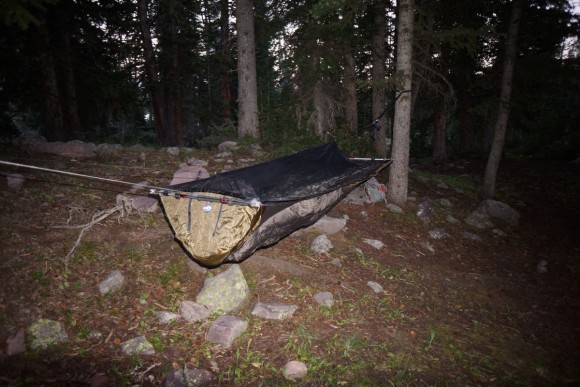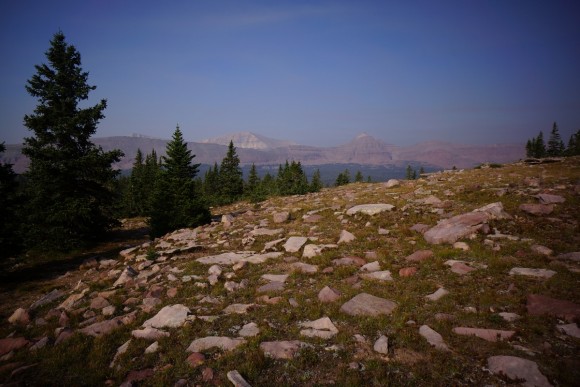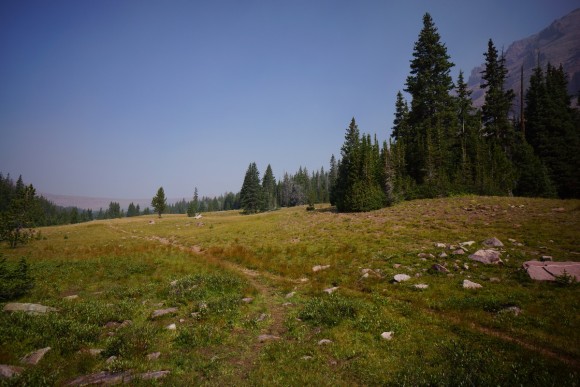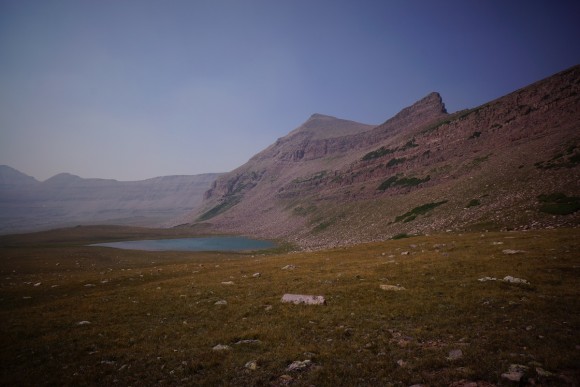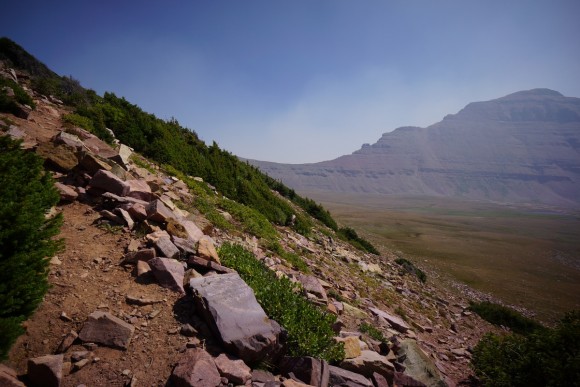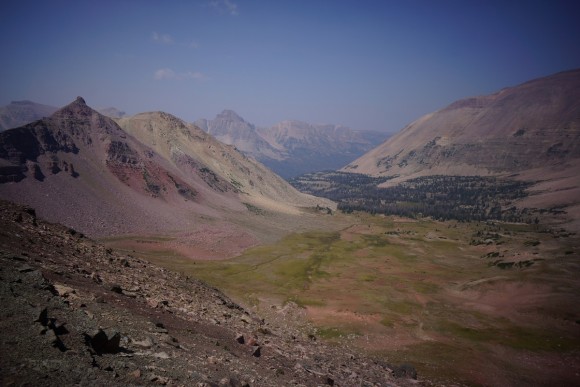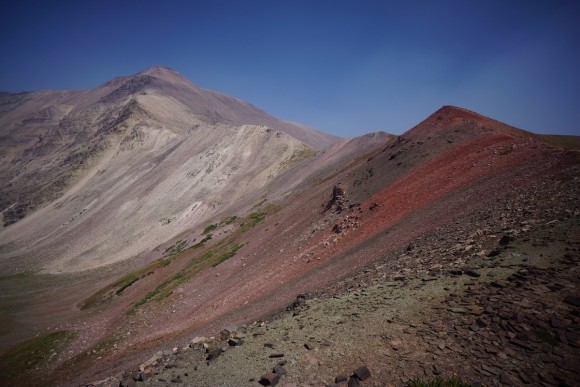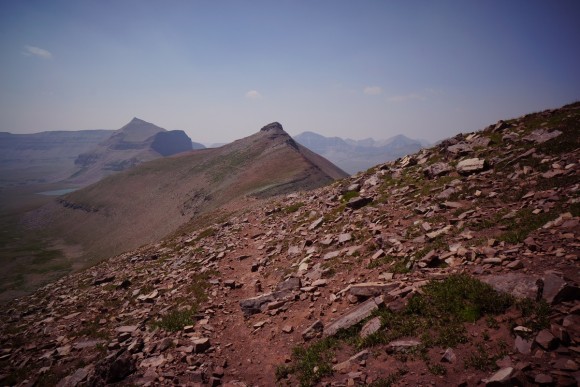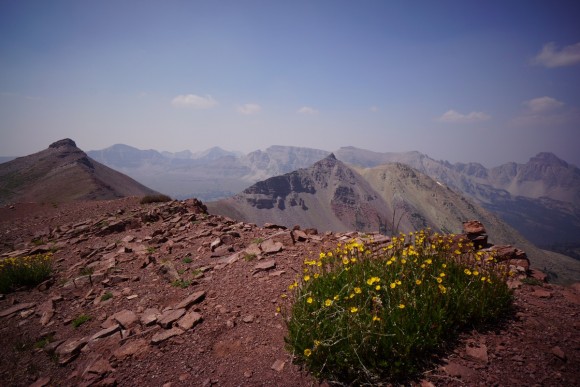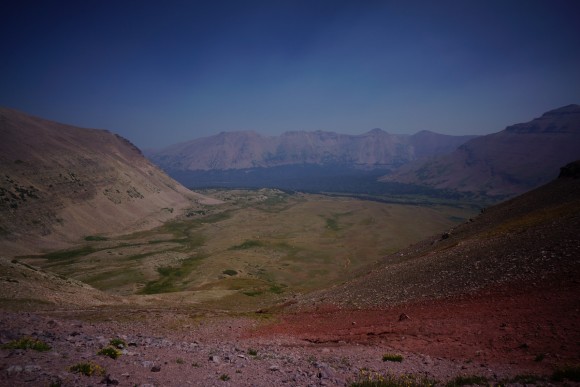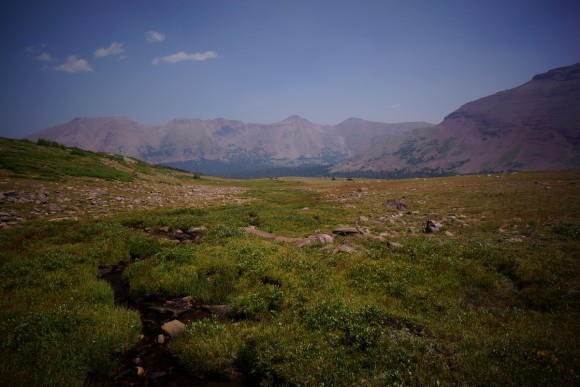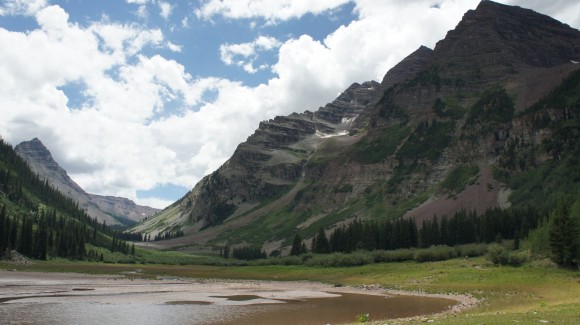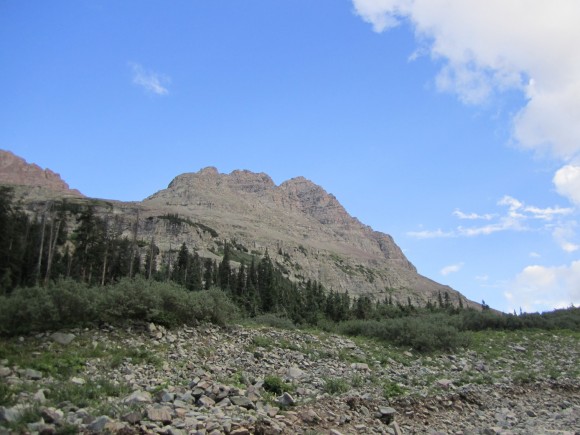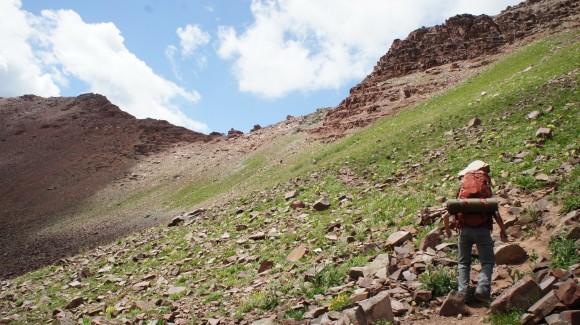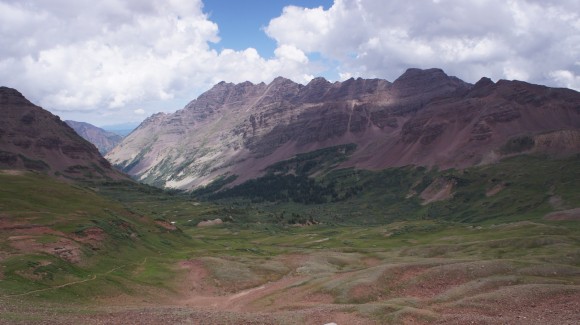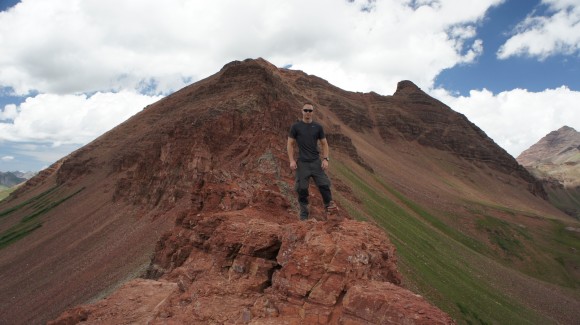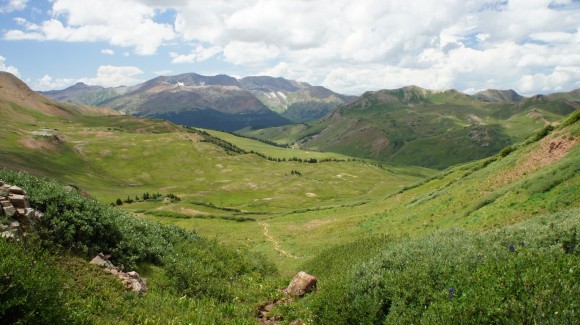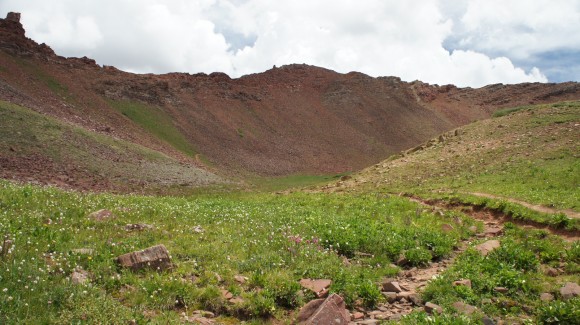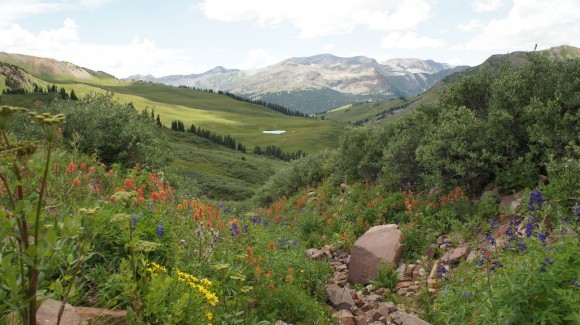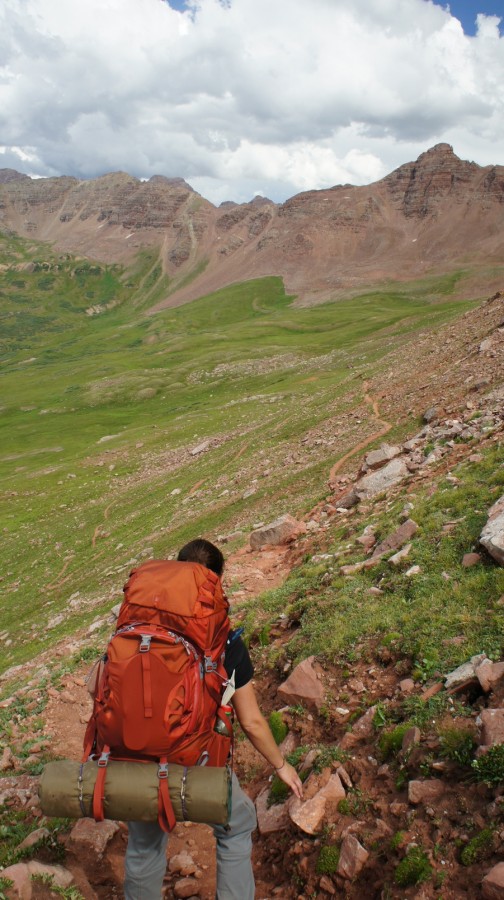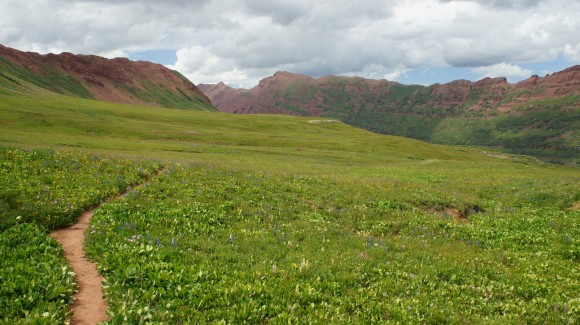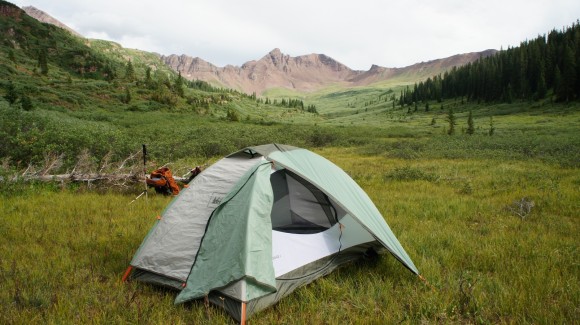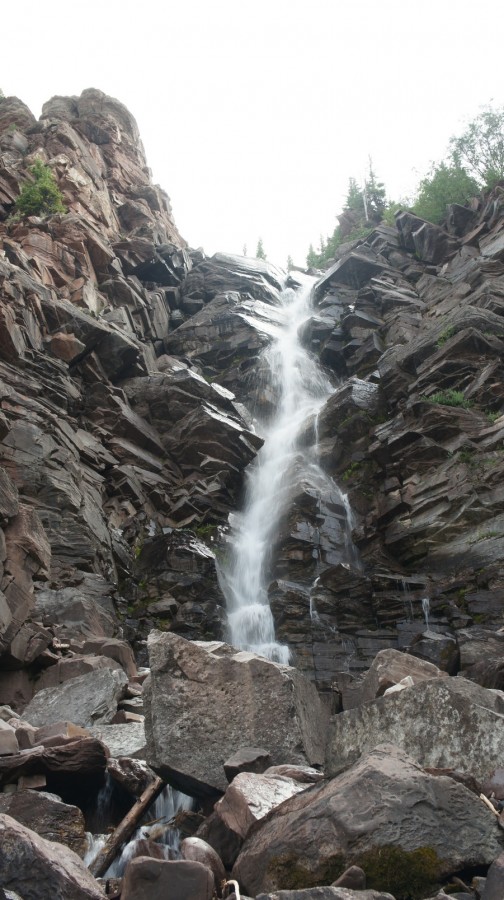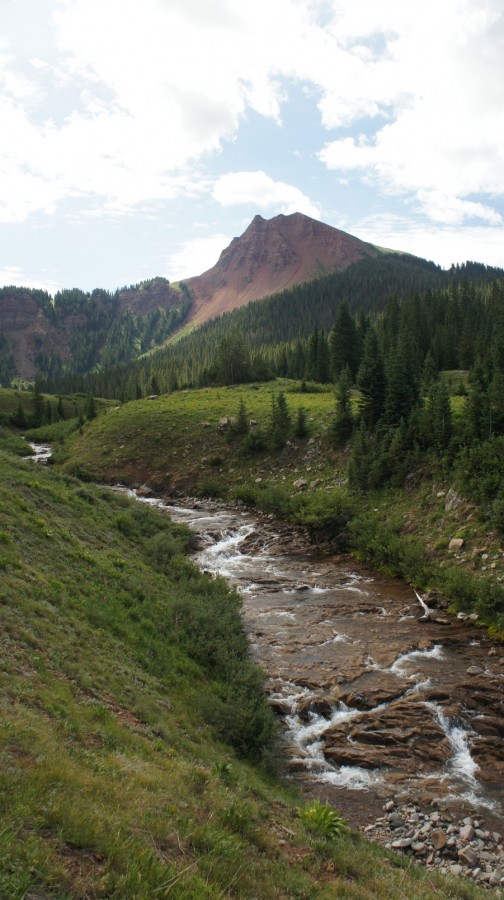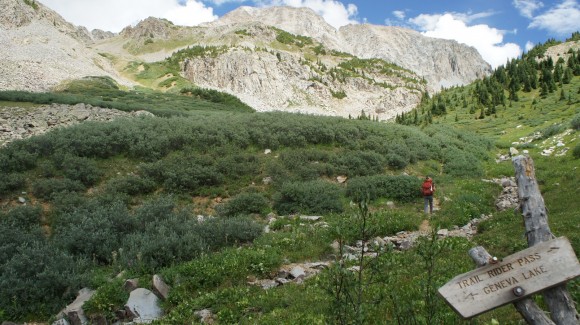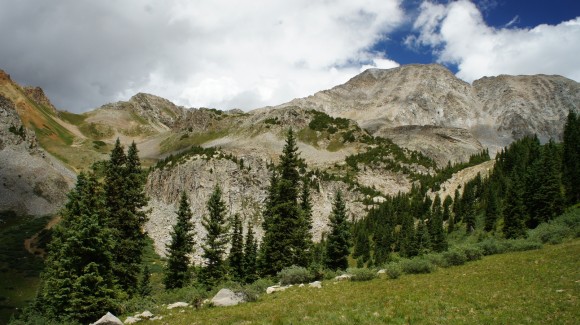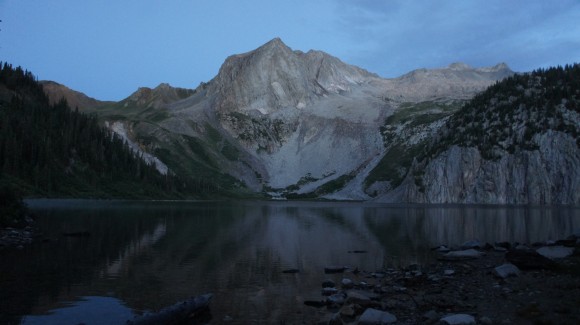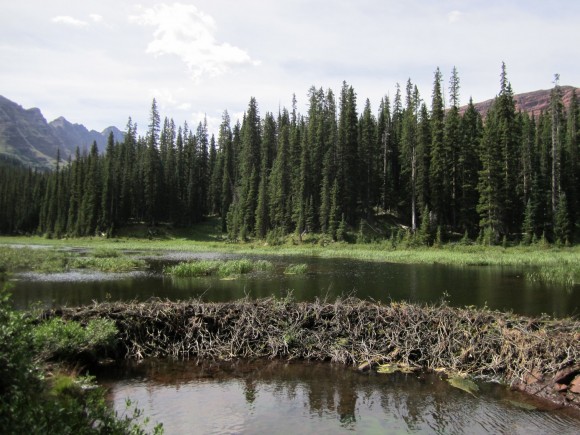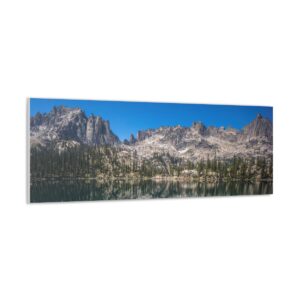Seven Devils Mountains, Idaho – He Devil Summit Hike (July 2021)
Seven Devils Mountains, Idaho – He Devil Summit Loop Hike
Watch the He Devil Summit Hike Video On Youtube
- Hike Location – Seven Devils Mountains, Idaho – Hells Canyon Wilderness
- Land Administration – Hells Canyon National Recreation Area, managed by the Wallowa-Whitman National Forest
- Hike Type – Loop
- Fees & Permits – No fees or permits needed
- Trailhead – Windy Saddle
- Length Of Time Hiked – 1 day
- Miles Hiked – 15.56
- Route Difficulty – 7.5
- Scenic Beauty – 8
- Solitude – 8
Video: He Devil Summit Loop Hike – Seven Devils Mountains, ID
Pre-Hike Planning Notes
There are no fees or permits required to hike in the Seven Devils Mountains. The road up to Windy Saddle is doable by car, but it’s a bumpy ride in places with a lot of washboard roads. There are a lot of steep inclines, your vehicle will be working hard to get up here. There is a FREE campground a half mile from the Windy Saddle Trailhead called the Seven Devils Campground. This is a great place to stay the night before your hike, if doing a day hike, or perhaps the night after finishing your hike. There is no water up here. There are pit toilets at the campground and the trailhead.
He Devil Summit Hike Maps
Here’s the caltopo map of my He Devil Summit Loop Hike:
Download GPX file for the He Devil Summit Loop Hike
He Devil Summit Hike – July 15th, 2021
Miles Hiked – 15.56
Elevation Gain – 5300′
Route Hiked – Loop hike from Windy Saddle to He Devil Summit and back
My buddy Sam and I slept in the Seven Devils Campground last night in my camper van, about a half mile from the Windy Saddle Trailhead. This made it easy to get an early start on today’s hike, a loop that bags the summit of He Devil, the highest point in the Seven Devils Mountains of Idaho at 9,393′. We’re on the east side of Hells Canyon, the deepest gorge in the US, within the Hells Canyon National Recreation area and the Hells Canyon Wilderness. We had a much longer hike planned for this area, but because of the thick forest fire smoke and high temperatures, we’re cutting this adventure short, and just doing a day hike to the summit of He Devil.
There were maybe 4 other vehicles parked at the Windy Saddle trailhead this morning. We started walking just as the sun crested one of the hills above the saddle. Through the thick forest fire smoke, it was an orange ball of fire. Pretty cool looking, but also pretty sad that we won’t get the distant views we were hoping for here.
The trail begins by dropping in elevation from the trailhead and traversing a massive area of dead trees. The trail was clear, thankfully, but this area just looked dead and barren.
After dropping to 7,200′, the the trail quickly begins to climb up in elevation now, traversing a ridge facing northeast. We’ll climb to 8,000′ as we round the corner of a ridge. Our first big views towards Hells Canyon would have been here, but the thick forest fire smoke obscured them. There are some nice purple wildflowers up here along the trail, especially prospering in some of the old burn areas.
Next we drop in elevation again, from 8,000′ to roughly 6,600′ as we drop down into the canyon with West Fork Sheep Creek. Switchbacks at the top make quick work of the biggest descent. Soon enough, we trade mountain views for the cover of the forest. Here, things are green and lush, thriving, unlike the valley we started our hike in.
West Fork Sheep Creek was a solid flowing body of water, with some small cascades. Very nice, very pleasant. Then we climbed out of the forest again, and our mountain views returned. This was some pretty solid high mountain scenery, especially considering the surrounding area of Hells Canyon which doesn’t really have anything else like this nearby.
The trail leads us up and out of West Fork Sheep Creek and leads us to a pass between Dry Diggins Ridge and Lily Pad Lake. It’s pretty flat here at the moment, with a great view of the hazy mountains in the distance. There’s lot of water here now, and the route will pass by 5 small lakes on the way up.
While hiking through another patch of forest, in between Lily Pad Lake and Basin Lake, we spotted a Mountain Goat alongside the trail. He was pretty chill, just doing his own thing. Always cool to see.
Now the trail continues to climb uphill around Shelf Lake, and then passes Gem Lake. The trail stays a distance away from both lakes, though, staying elevated above them. Good trail, good views.
The trail climbs above Rock Island Lake, again with no real view of the lake. Soon though, we leave the trail and begin our hike off-trail through a boulder field to continue our route up to the summit of He Devil.
Next we worked our way out into a large boulder field in order to reach the ridgeline. The route wasn’t too bad, just slow and tedious.
I should have stopped to fill up on water at one of the creeks we passed farther back, but I didn’t. I figured I’d gone past the last liquid water source, and I turned to a snow bank for water now. I stopped to fill up two 1 liter bottles with snow, and will let them melt as I carry them.
There was one steep section to climb before gaining the ridgeline. From here, it’s a straight shot up to He Devil. There’s sometimes a path to follow, but also, it’s occasionally a bit of a scramble up the boulders. The views are as good as they can be with the smoke.
It was a good hike along the ridgeline. The route is not super well defined, but easy enough to figure out on your own. It was mostly a fun walk up. The final approach to then summit block required a short bit of scrambling to reach, with no exposure.
The views form the summit of He Devil were awesome, even with the forest fire smoke. It’s an impressive ridgeline, with a view of the other 6 “devils”. It’s just the kind of ridgeline you want to find your self on top of. However, because of the smoke, we had practically no view of Hells Canyon, the deepest gorge in the US. I could see the outline of the Oregon side of Hells Canyon in the distance, but just barely. I wondered how the view would be, on a clear day. At it’s deepest point, Hells Canyon is 7,993′ deep. That’s a pretty serious landform, just the kind you’d want to overlook from a peak like this.
The hike down from the summit was pretty quick and easy. Just a return hike down the same ridgeline for now.
When we dropped down from the ridgeline, we took a slightly different route on the way down than we did on the way up. We made it down a section of steep and loose boulders and reached a snowfield. Sam and I had been talking about our skiing abilities, hat is, the ability to slide down the snow on your shoes, like skiing. I’m pretty decent at this, and made my run a couple hundred feet down hill with no poles, and didn’t fall. Sam bit it after a few feet, and glissaded the rest of the way down. Good times.
After a tedious walk through the lower section of boulders below He Devil, we reached a more suitable hiking terrain of soil, green grasses and small rocks. We find ourselves on a saddle, which we crest for our first close view of Sheep Lake.
We picked up on a hiking trail again as we descended down to Sheep Lake. Now we have good trail and outstanding views. Once down at the lake, it was the obvious place for a break. I drank some of my snow melt water here, which was freezing cold. I also filtered some water from the lake, which was a much more tolerable drinking temperature.
Next we traversed the south shores of Sheep Lake, below She Devil. There’s a short section of boulders here, otherwise it’s a nice grassy walk. The shoreline wraps around to another smaller lake, an off-shoot of Sheep Lake. Nice views here too. This would make an excellent place to camp, if we were staying the night. But we aren’t, so it’s back to the van.
Now we are looking for a trail that could connect Sheep Lake to Mirror Lake. From the other side of Sheep Lake, it doesn’t look like it would be a good route, too steep. From up close, it looks very steep too, but we started to see a weakness in the mountainside that could allow a path to hike up. USFS and USGS maps don’t show a trail here, but OpenStreet maps does. Interesting. We thought we could see a very faint path to follow as we hiked up the steep slopes, so it was a good sign. Additionally, there was indeed a narrow ledge, more or less, that allowed for easy passage compared to the surrounding terrain. Things are looking good.
At one point, we had to squeeze through two rocks, a space barely big enough to fit with a backpack on. Past this, there was more steep terrain, but it’s all been manageable. This route has really worked out. This is way more direct, shaving off several miles of hiking versus the way we started the hike this morning. It’s a different route and it’s scenic, so its a win-win.
Mirror Lake
After cresting the pass, Mirror Lake came into sight. This was a really nice lake, and well hidden from the Seven Devils Campground, but just a few hundred feet away. For now, a steep descent stand in the way. There was some slippin’ and slidin’, but we both made it down in one piece.
We made it down off the steep slopes and hiked over to Mirror Lake to enjoy one last view of this fine alpine lake. I didn’t expect much out of this lake, because it was so close to the Seven Devils Campground and honestly, because it was tucked away in an otherwise ugly spot, with all the dead trees and such. This was a really nice surprise and a nice way to end our He Devil summit loop hike. From here, it’s about 1/2 mile back to the Windy Saddle trailhead where we parked.
High Uintas Wilderness, Utah – 8 Day, 95 Mile Solo Hike Aug 2015
High Uintas Wilderness Hike Overview
View ALL my pictures from the hike here: High Uintas Wilderness Photos
View a HD video of this hike on youtube: High Uintas Wilderess 8 Day Solo Hike
- Location – High Uintas Wilderness, Utah
- Park Type – National Forest, Wilderness
- Park Administration – Ashley and Wasatch-Cache National Forests
- Trailhead – Start & end at East Fork Black’s Fork trailhead
- Fees & Permits – No fees or permits needed for hiking. Parking pass may be needed depending on the trailhead
- Length Of Time Hiked – 8 days, 7 nights
- Trail Type – Loop
- Miles Hiked – 95+
- Trail Difficulty – 7.5
- Solitude – 7.5
- Scenic Beauty – 9
- Fires Allowed – Yes, with some restricted areas
[sgpx gpx=”/wp-content/uploads/gpx/Uintas2015Route HikedOneTrack.gpx”]
About The High Uintas Wilderness
In 1984, congress set aside 456,000 acres in the Uintas Mountains in northeast Utah to become the High Uintas Wilderness. Along with the Transverse Mountain ranges in California, the Uintas are the only mountain range in the lower 48 that runs east to west, and is certainly the largest of them all. The Uintas contain the tallest peak in Utah, King’s Peak (13.527ft), all of the 13,000ft peaks and half of the 12,000ft peaks in the state. There are over 1,000 lakes in the Uintas wilderness, and about half of them contain trout.
High Uintas Wilderness Maps
Here’s my Caltopo map, where I created the route:
High Uintas Gear List
Osprey Exos 58 pack
Warbonnet Outdoors Riderunner Hammock
Warbonnet Outdoors Superfly Tarp
Warbonnet Outdoors Lynx underquilt – full length 20°F
Hammock Gear Burrow 40 top quilt
Clothing:
Footwear – Inov 8 Roclite 295s
Dirty Girl gaiters
Insulation – REI Rauk jacket
Base – Patagonia Capilene I top and bottom
REI zip off shorts/pants
Nike Dri-fit shirt
Outdoor Research sombrero
Outdoor Research rain jacket and pants
Camera gear:
Sony Nex-7
18-55mm lens
16mm lens
3 batteries
Home made 4.7oz tripod
A couple filters, remote shutter control, extra SD card, etc
GoPro Hero4 Black Edition
6 batteries
Flow-Mow time-lapse panner
Head and chest mounts
Garmin Oregon 450 GPS – It takes 2 AAs… I use Energizer Ultimate lithium batteries and had 4 extras. I usually get about 3-4 days out of a pair.
Cookware – I normally go stoveless, but after catching fish and having no wood for a fire in the Winds last year I decided just to bring the stove so I had a sure fire way to cook fish if I caught them.
Knock-off MSR PocketRocket stove
Propane/Butane mix fuel
Small non stick frying pan
And all the other typical extra stuff… firesteel, headlamp, cordage, first aid kit, toiletries, etc.
I did bring my cell phone but only used it a few times to play music.
Getting There
The Uintas Mountains are in northeast Utah, about 1.5 hours east of Salt Lake City. Highway 150 (Mirror Lake Scenic Byway) runs from the town of Kamas on the westerly end of the wilderness north through Hayden Pass and on into Evanston, Wyoming. FR-58, or “North Slope Road” is the main road that run east and west on the northern slope of the mountain range for access to the north slope trailheads, such as West Fork Black’s Fork, East Fork Black’s Fork, Henry’s Fork, and others.
Day 0 – Travel Day
Today I flew in to Salt Lake City, arriving around 8:30pm. My previous two flights on American Airlines, they lost my luggage. The first time it took them a day and a half to find it, delaying the start of my hike. The second time wasn’t for a hike but still ruined my first day. Between both those flights, I only received a $50 voucher as compensation. Pretty insulting if you ask me. However, this time they delivered my luggage as expected, bringing them up to a laughable 1-for-3 record. Yay. After picking up my bag, I got in my little Toyota Yaris rental car and headed towards the Uintas. I made a quick stop in Park City along the way at their 24 hour Walmart and bought some fuel for my stove, since I can’t bring that on an airplane. That, and a case of water. I ate at Five Guys, a nice big burger for my last hot meal for 8 days. With all that done I continued on to the town of Kamas where I picked up hwy 150 and headed into the Uintas, in the darkness.
The plan for tonight was to drive a ways on hwy 150 and find a place to camp along the road once I got near Hayden Pass, which is over 10,000ft. Since I’m coming from about 500ft elevation, I really need to get one night of sleep in up here before I can think about beginning to hike at this altitude. Normally I give myself a little more time to acclimate, but this time I was trying to squeeze a lot into a limited amount of time.
I went over Hayden Pass and ended up finding a spot shortly after. It was about 11:30 pm at this point. With the car at my disposal, albeit a poor choice for a night’s sleep in the event of rain, I setup the hammock without the tarp overhead and just marveled at the stars above. The new moon is tomorrow so this is about as bright as they’ll be in this area for a while. Ah, I slept great.
Day 1 – Thursday August 13th, 2015
Miles Hiked – 8.5
Route – East Fork Black’s Fork trailhead to 10,400 ft mark in Little East Fork drainage
Day 1 Map
I woke up at 7:45 this morning, in no hurry to get moving. Since I’ve only been up here at altitude since 11pm last night, I figure I’ll wait til at least noon before I begin hiking. Once I got back on hwy 150 north, I had to stop for a heard of sheep just hanging out in the middle of the road. Little did I know that wouldn’t be the last I’d see of sheep. Eventually I hit FR-58, North Slope Rd and headed east. After driving 18 miles or so, I made a right on FR-65 which takes you to East Fork Black’s Fork trailhead and campground. FR-65 is really, really rough. It’s really rocky and has lots of big craters. My little Toyota Yaris rental car made it, but damn was I scared of getting a flat. And it’s painfully slow going. So you can take pretty much any car out here I guess, but have a spare on hand just in case.
I pulled into the trailhead just before noon and started doing the final loading and checking of my backpack. Pack weight was pushing 50 pounds with about 20 pounds of food and a full load of water. I was planning on 2 pounds a day for 9 days, plus some extra stuff. This was in response to losing 15-20 pounds during an 8 day hike in the Wind River Range last year, when I ate all of my 13 pounds of food. I didn’t want to be hungry again. By 12:30 I was on the trail, excited for the adventure that lies ahead. The first step of a journey like this is always profound… I’m excited, anxious and apprehensive about the things I might have forgot to bring or about the possibility of something going wrong along the way. But that’s what I love about doing this… no matter what happens, it’s always an adventure.
After registering at the trailhead, I proceeded across the foot bridge and made a right, heading into the Little East Fork drainage. Here I saw the only other person I would see today, heading back to the trailhead. Shortly after, the trail crosses several smaller streams and then a few wider ones. After a mile or so, the trail splits off; East Fork Black’s Fork to the right, and Little East Fork to the left. I’m staying to the left the way in, and finishing the loop by taking EFBF back.
Now I’m making my way up the Little East Fork drainage. The trail winds through pine forests and some meadows with an occasional stream crossing. None are deep but at least two of them I was not able to hop rocks across, and had to ford. I didn’t see any established campsites the whole day while I was hiking through here. This drainage was not spectacular but had some pretty sections closer to the top. It didn’t look it was very well traveled though.

After hiking 8.5 miles I called it a day. I made it to the 10,400ft mark. I planned a short day here because I know I need more time to acclimatize, and not to push it too hard on the first day. Just in time too, as it was beginning to sprinkle. There really weren’t a whole lot of good spots to hang my new hammock, a Warbonnet Ridgerunner. Either the trees were too small, too close together or too far apart. Eventually I found an area on a bit of a hill that would work. Having set up the hammock in the field only once, and spending two nights in it, I was still learning my way with it. I spent quite a while setting up the tarp, a Warbonnet Superfly. After getting the hang of some knots like the slipped buntline hitch and slipped truckers hitch I had the thing up ready for the rain.

I decided to take a nap in the hammock for about 45 minutes until the rain let up. It wasn’t raining hard at all but enough to make me wait it out. Today was a little harder than I expected. I did a really good job staying hydrated all day until I reached camp. When the rain stopped I headed down to Little East Fork creek to filter some water. Mosquitoes were not too bad, only a couple bites occasionally. After getting water and washing up I headed back up to camp. I wasn’t too hungry tonight though. High altitude and exertion seem to suppress my appetite. I made myself eat what I could. I didn’t seem nauseous or physically bad in any way, just no desire to eat. And foods taste more bland.
It still looked stormy when I went to bed at 9:30 tonight. Hope that clears up. The real views start tomorrow.
Day 2 – Friday August 14th, 2015
Miles Hiked – 11.1
Route – 10,400 ft mark in Little East Fork drainage to Yellowstone Creek campsite below Anderson Pass
I slept pretty good last night. The sun was shining and the storms had passed, but everything was still pretty wet. I got on the trail around 8am this morning and continued uphill. It wasn’t long before I was nearing the treeline and those big views I’m looking for. As the trees petered out, I caught a glimpse of two large black animals. My first thought was moose, but I didn’t get a good enough look at them. Shortly after I saw another group of animals, 2 black and 2 white, that I think were sheep. They ran off before I could tell for sure. Again, not that last I’d see of sheep this hike.
By 9 am I was standing on Squaw Pass with my first “big” view. Once at the top of this pass you are greeted with a cairn as expected as well as the skull of a horse, I believe. The view to the north where I came from off into Wyoming was impressive, however, the real jaw dropper was the huge open valley below. This is where I’ll be descending in a minute, after a some pictures and a quick break.
The weather looked like it wants to rain eventually, so I made my way down the pass and out of the wind. Squaw Pass isn’t as tough as many of the rest of the passes along this trip, but since I had 3 passes to traverse today I wasn’t complaining! The trail down Squaw Pass heads southwest, but I want to be going northeast, towards Porcupine Pass. Once I dropped some elevation I left the trail and cut across the hillside, taking what I always perceive to be a shortcut; the most direct path. Here in this open valley, it probably did save me a little time even though I didn’t catch up with the trail again til the base of Porcupine Pass.
Hiking through this valley was cool. To the southeast and parallel to my route was a very impressive chain of mountains ranging from 21,100 – 12,800 ft. They are unnamed on my maps, except for Stone Peak.
The trail up Porcupine Pass was not visible until you’re right up close to it. On the way up the pass, I came across and area where trail workers had just dug out a good section of trail along the upper stretches of the pass. Shovels and pick axes were left at the turn in one of the switchbacks. I was on top of the pass by 11:15, but the threat of rain loomed. It was windy and sprinkling up here so I didn’t stay too long.
After descending Porcupine Pass and continuing east, the trail winds through Garfield Basin. This area was pretty barren, and somewhat reminiscent of the Wind River Range in that way. Still, it was surprisingly beautiful. It was pretty easy hiking through here, all the way to Tungsten Lake where I stopped for a quick break. I hear this lake is great for fishing, along with Superior and North Star if I remember right. However, I didn’t do any fishing here. I was more focused on getting to camp and beating the rain, which I thought was inevitable. I took my shoes off to air out my feet and ate some food before it started sprinkling again. As soon as I get everything packed up and moving, it stops. Not complaining!
Now leaving Tungsten Lake, it’s time to head up Tungsten Pass. Approached from the west as I did, this pass was a joke compared to the others, at about 60ft elevation gain above Tungsten Lake. Nice, since it was my third pass of the day. The colors of the mountains were really cool up here. Not red like you think of when someone mentions Utah, but different.
Descending Tungsten Pass now, a new valley opens up to me. Through here flows Yellowstone Creek. The trail I’m following stays high up in the basin and works it’s way towards Anderson Pass and King’s Peak to the northeast. Starting from a high of 11,400ft at Tungsten Pass, the trail dips as low as about 11,000ft on the way to Anderson Pass, so it does a fairly good job of maintaining elevation through this area.
My intended campsite for today is the last patch of trees before the climb up to Anderson Pass. The satellite view of this area shows trees but it was difficult to tell whether or not they’ll be suitable for hanging. Once I reached the area in question, I could see that hanging the hammock would not be a problem. However, it still took some effort to find a spot to hang from. Setup time was faster today.
After making camp I set up the GPro to try my hand at a time-lapse. I used my new Flow-Motion time lapse panning device to get that slow, smooth pan during the time lapse. The wind knocked the tripod over halfway through it’s pan though. Since the time lapse mode requires the camera to be on for so long, battery life is the biggest hurdle. I did have 6 batteries for the GoPro, but at least one was for a night lapse later on, and the other 5 for the 8 days of hiking.
It was a pretty decent afternoon despite the constant perceived threat of rain. Fishing was not possible here through due to the size of the creek, which was just a trickle really.
After that I decided to lay down in the hammock while I reviewed my maps for tomorrow. So there I was, just laying there, and all of the sudden the hammock drops about a foot. It turns out that one of the tips snapped off on my trekking pole, which is being used as a spreader bar on the head end of the hammock. This was completely my fault as I would soon learn. For now, I told myself it was a fluke incident and began to look for a way to continue using the pole as a spreader bar. If this doesn’t work, I’m pretty much screwed. First thing though, I had to find the pole tip adapter piece which was nowhere to be found. I eventually found it laying in the dirt more than 20 feet away.
I shaved off the remaining plastic around the end of the broken pole tip, exposing the metal pole’s end. This still fit into the trekking pole tip adapter piece that I was using before, but it was looser than before. With this pole all fixed up, I moved the good pole from the foot end spreader bar over to the head end, and the broken pole over to the foot end. It was only a minute or two before the one remaining good pole had it’s pole tip snap off as well. What the hell?
With both poles broken now, I was forced to take a closer look at what was causing this to happen. After all, everything worked fine the last 2 nights I slept in the hammock using the same setup. The problem ended up being that I made the spreader poles too wide. I measured the existing spreader poles at home, but never made any markings on the trekking poles to indicate the correct length. I really didn’t think it would be an issue if either pole was an inch or two too long or short, but it makes all the difference. I made the poles too wide, which made the angle at which the pole tips sit in the metal brackets on the rigging lines off enough to put a tension on the tips, snapping them off.
I saw a deer grazing a few hundred feet away as I got my fire lit that evening. The sky cleared and the stars were out again as the sun set. I was nervous about my hammock holding up for the night, and the rest of the trip for that matter, as I hopped into bed.
Day 3 – Saturday August 15th, 2015
Miles Hiked – 10.3
Route – Yellowstone Creek campsite below Anderson Pass to Milk Lake
My trekking poles held up through the night with no issues, thankfully. When I woke up this morning though, the sky was pretty cloudy and it looked like it was building. Since the weather looked so bad I didn’t want to head off to Anderson Pass and get caught on top during a lightning storm, so I waited. This was really threatening my Summit attempt of King’s Peak as well. Fortunately, the clouds broke some after about an hour and I decided to break camp.

This is basically the crest of the Uintas Mountains, running east and west through the northern end of Upper Yellowstone Basin
Immediately after leaving camp the trail heads uphill for a while. I couldn’t believe it to be honest, but the clouds kept dissipating, revitalizing my mood. It wasn’t long before blue skies were the majority. Soon the treeline was below and I was on the final “shelf” leading up to Anderson Pass. Looks like I may be able to summit King’s Peak after all!
The trail up Anderson Pass wasn’t visible until I got pretty close to it, then the switchbacks became apparent. The trail itself was in pretty good shape but it was a tough climb. As I approached the top of the pass I could see people up there, and heading up King’s Peak. From the hike up Anderson, I could barely spot King’s Peak. It doesn’t tower above the surrounding ridgeline. You would never know it’s the tallest peak in the state from this vantage point.
When I got to the top of the pass I was not alone. There were 7-8 other people up here, with many more headed up the pass from the other side, and many more headed up King’s Peak above me. This was quite the influx of people compared to what I’d seen the first 2 days. I also noticed nobody had more than a small daypack on. I was the only one up here out of about 50 people I saw that had a fully loaded backpack. It turns out many of them were part of two separate large groups camping at Dollar Lake, and it seemed the rest were trail runners that had ran up here from Henry’s Fork Trailhead I believe.
Anderson Pass offered some great views. Many of the ridges in this area looked like a plate had been uplifted, and is overhanging the opposite side of the ridgeline. Pretty cool looking. I’m sure there’s a term for this but I don’t know what it is.
I took a break for a few minutes after that long climb up here before heading up to King’s Peak. I brought a small compressible backpack (2-3oz I believe) that I used in place of my Osprey pack for the climb up, and left the pack down at Anderson Pass. I set it out of the way a little bit since there were so many people, not that anyone would want to lug that pack around.
The climb up King’s was not bad. Since I had all that weight off my shoulders it felt like I was flying up there. The terrain was mostly a class 2 with some easy class 3 spots. Great views all the way up. At the top there was consistently about 15 or more people up there at any given time. We had to take turns at the summit block. But at least up here, I had someone to take my picture instead of using my tripod. That can be pretty awkward on thee types of boulders.
I stayed on the top for a while. No rush to leave a view like this. Plus, with the weather constantly changing, so do the photographic opportunities. The clouds grew darker and darker just beyond Anderson Pass, and rain was not far off in the distance.
When the weather finally convinced me it was time to go, I made it back down to the pass pretty quick, and without getting wet. People were still headed up to summit King’s as I descended Anderson Pass into Painter Basin. Many of the people camping over at Dollar Lake were taking a shortcut back. Instead of going down Anderson and up Over Gunsight Pass, they headed down a rock chute at the 12,450ft mark on the map about a 1/4 mile northeast of Anderson Pass.
I enjoyed the hike coming down into Painter Basin. All around me it seemed to be raining but never actually on me. It was as if there was a clear spot overhead following me around, while anything outside of my radius saw rain. Not complaining! Plus, it allowed for some cool pictures of the rain coming down, without me (and the camera) being in the rain itself.
The further I hiked into Painter Basin, the larger it looked. It looked like a full day’s hike on the map. Fortunately I was only headed to Milk Lake, which most of the people I spoke with on King’s Peak weren’t familiar with. It’s a little off trail, just below the Crest of the Uintas tucked away out of sight a few miles into the basin. Eager to get to my destination, I decided a shortcut would be the quickest way to get there. I had my doubts about a trail running form the main trail over to Milk Lake once I got near it, and so a direct off trail route didn’t seem like a bad idea.
Bushwhacking my way towards Milk lake wasn’t terrible, but was no walk in the park either. Mostly it was a mix of some random boulder fields and choke points between the shrubbery that cut up my arms and legs a little. But that’s off trail hiking for you. Or, on trail hiking in Arizona, the “Stabby Cactus State”.
I got my first view of Milk Lake from a small hill above. I could see that finding a good set of trees to hang the hammock from might be a bit of a challenge. Definitely not going to get that near the lake itself which I was hoping for. I had to stay high above the lake on a hill where the trees were, which was a few hundred yard walk down to the lake. My spot wasn’t very aesthetically pleasing, but if I wanted to camp by this lake, this was my best bet.
Lots of animal crap around here in this area. Tons of it, really. I could barely find a spot to step without it. Elk and deer crap mostly. I got the hammock up and the tarp secured in place, ready for whatever the weather had in store for me. It still looked like it was going to storm at some point today.
After getting camp setup, I headed down to Milk Lake to get some water and do some fishing. I could see tons of fish swimming around the shallows, but they weren’t very big. Maybe 6 inchers. These little guys couldn’t resist my Mepps spinner, and I caught 10 or 12 Cutthroats in a half hour or less. I suppose I could have walked around the lake but I figured they were all going to be pretty small in here and abandoned the idea of eating fish tonight.
After fishing I decided to wash up. With nobody around, I stripped down and jumped in the water for a more thorough cleaning than the previous days. Yup, that water is just as cold as you think it would be. But, it’s undeniable how good it feels to rinse all the filth off from a couple of days on the trail.
I was going to cook a tortilla with cheese and pepperoni in the drying pan down by the lake but the weather didn’t look like it was going to hold out any longer, and I headed back to camp. Somehow the rain never came, and I ended up cooking a few hundred feet from camp instead. With no view from my campsite and the gusty winds, I just headed to bed shortly after sunset.
Day 4- Sunday August 16th, 2015
Miles Hiked – 12.9
Route – Milk Lake to Bear Lake
Most of the night the stars were shining bright above me, but lightning flashes flickered in the distance. The rain started sometime after 5am and continued for at least 2 hours, with some hail as well. Very windy too. After the weather had passed, I emerged from the hammock around 8am. With everything soaking wet now I packed up and was ready to hit the trail for another day. There was also some strange animal noise pretty close to camp alst night after I got in the hammock. I have no idea what it was, but at times it was really close.
I didn’t feel like hiking the off-trail route I chose yesterday back to the main trail, so I decided to follow a small gully that the overflow from Milk Lake would take downhill. I passed a small lake and then further downhill I came to an open rocky area with a good view. After I descended a short section of boulders, I picked up a trail which was heading towards the main trail.
Walking through the forest on my way back to the main trail I saw two elk scamper away as I approached. I’m always surprised at how little wildlife I see on journeys like this. Do I just make too much noise and they hear me coming? Am I out at the wrong time/place? Maybe I stink and they smell me coming from miles away. Either way, two elk under the belt. Hope to see more.
Eventually I hit the main trail and headed west towards Gunsight Pass. Even though I hiked through part of this valley yesterday coning down from Anderson Pass, the majority of this morning’s hike will be on a different trail. There was a big open meadow down in the center of the valley that had a couple of nice campsites along the tiny streams that ran through here. Later, I saw a few horses grazing along a lake below me, but no sign of people. Nice hiking through this section.
Next I approached Gunsight Pass, which didn’t appear to be as challenging as Anderson or Porcupine Pass. It sprinkled lightly as I made my way up. All in all it was about 5 miles from Milk Lake to the top of the pass.
There were two horses “parked” up here on the top of Gunsight Pass, a little bit above the area where hikers would walk through. I didn’t stay up here long, just snapped a few quick pictures and headed down into the new valley, Henry’s Fork. This is where those large groups of people were supposed to be camping, so I was expecting a lot of people.
The more and more I descended, the more I liked this area. I managed a few decent pictures through here but the sun washed out a lot of them. This is one area I wish I could have camped, and seen a sunset and sunrise from. But instead, I’m blazing through it, trying to get to Bear Lake. Still, excellent hiking this afternoon coming down from the pass.
A bit further down, I encountered my first herd of sheep on the trail. I could hear them bah-ing from a way away. I continued along my path on the trail and they scampered off as I approached them. There were at least several hundred of them.
There were some really nice campsites above Dollar Lake. I passed a few people through this area, as well as a few people earlier while descending Gunsight Pass, but still not seeing the large groups of people I was expecting. After passing Dollar Lake, I was looking for Elkhorn Crossing. I reached an area where the trail came right up to the river and wasn’t going to be cross-able without getting wet. I thought this was odd that Elkhon Crossing, a marked area on the map, didn’t have a footbridge here as I was expecting. After fording the river and walking upstream a bit, I saw a makeshift bridge wade from logs that would have been the actual crossing. Duh, I should have scouted the banks. Oh well, I used the horse crossing.
I had spent most of the afternoon walking downhill, and now had the final 400+ feet to climb for the day over thew next 1.5ish miles. Most of it was in the switchbacks right after crossing Henry’s Fork. This section wasn’t that great for views down in the forest, and so I was haulin’ trying to get to Bear lake.
When I reached the lake, I followed the hillside down to the shoreline and followed it around the lake. I settled for a spot near the stream outlet on the east side, where it drains into Sawmill Lake. There was a large boulder that would have been nice to have a fire behind, but instead I thought it would be best used to block the wind from my hammock. There were two trees behind the boulder that were perfect, and as windy as it was right now, this was important!
As I was setting up camp I was feeling a little sluggish. I had been going for a while now and so I took some time to eat a little, chug some water and put on some music. I don’t ever listen to music while hiking, but sometimes I get a song stuck in my head. This trip, it’s been Corrosion of Conformity – Seven Days. So I put that on as I set up the hammock, and along with the food and water, I felt a lot better.
I guy I spoke with up on King’s Peak was telling me to fish the north shore of the lake. The south and east shores didn’t look great so I figured that’s where I’ll start. It was a little deeper over there, and had a couple of areas where you could actually cast from. However, I only caught one fish, maybe 8″.
As soon as the sun went down behind the mountain, the wind died down with it. I finished getting water and washing up and headed back to camp. I was able to have a fire now, and promptly got one going. As soon as the stars came out I was off to bed.
Day 5 – Monday August 17th, 2015
Miles Hiked – 11.6
Route – Bear Lake to Lower Red Castle Lake
I woke up at 6:45 this morning to catch the sunrise over Bear Lake. It was a pleasant sunrise but not as photo-worthy as I hoped. I went back to camp and finished packing up everything for the day. By 9am I was working my way along Bear lake towards the north shore, where I came in yesterday afternoon.
Next up was hiking to the top of Flat Top Mountain. The trail going up was nice, with good views of Henry’s Fork Basin.
At the top, it’s just like you’d expect from the name; very flat. Pretty cool up here though. Looking back the way I came up, the flat ground looks like it just drops off, with mountain peaks sticking up beyond that.
Now to descend Flat Top Mountain and hook up with the East Fork Smith’s Fork Trail. Eventually the flat open land gave way to forest as it sloped downhill. At first the trail was easy to follow, but after a while it became more elusive. I knew where I should be but the trail I was on was taking me further from it. Eventually I was forced to head down a hillside with a decent slope and laden with fallen trees to take the most direct route to it. This brought my to a marshy lowland area. I worked my way around and up onto slightly higher ground where I was relieved to finally be reunited with the trail.
I walked a short ways before finding a spot to take a break. After this I didn’t take any pictures for several miles. This was one of my least favorite sections of my hike. There just wasn’t anything to see, being in the forest the whole time. The trail was really rocky for a large sections of it. Of course, after hiking in the high country for a few days, everything else looks less impressive. Either way I tried to haul ass through here and get to Red Castle.
Once I finally reached the East Fork Smith’s Fork trail, it was pretty obvious. The trail was now wide enough for a car to drive on, although still pretty rocky in spots. Lots of horse traffic too. They really tear up the trail. All the muddy areas were trashed, and tons of horse crap all over. Ha, so much for “leave no trace”. That goes for the sheep too.
The trail was now inclined at the perfect level for me to keep moving without being tired and needing to stop. I covered some good ground through here. At round 10’360′ there’s a bridge that crosses the river. Right here is your first view of Red Castle. Finally, destination in sight. My campsite I ended up picking on the north shore of the lake ended up being about 2.2 miles from here.
Shortly after the bridge I hit some switchbacks that go up about 300ft. Now the lake is really close. I wasn’t entirely sure where I’d end up camping, but I wanted to try the north side for a nice view of Red Castle. The trail winds around the west side of the lake, so I had to cross the creek again. Fortunately there was a good crossing spot near the mouth with some rocks to hop across on. It was around 2pm when found a good spot a little up hill from the lake to pitch the hammock.
After getting everything set up at camp I headed down to Lower Red Castle Lake which was only a few hundred feet away from camp. The shoreline here on the north side near the mouth wasn’t great, kinda soggy, few boulders to step on, shallow water and pretty much no fish. I worked my way around the shoreline clockwise until I found a good spot on the northeast side. There is one area here where a rocky outcrop butts up to the water, and it’s much deeper than everything else. I figured this would be a good spot to fish, or if nothing else, wash up and get water.
I got a couple of bites fishing here but didn’t catch anything. Really though, I didn’t care. It was just so damn nice out, I was content just being here. There wasn’t a cloud in the sky and the temperature was really nice, in the sun anyways. I just relaxed on this rock by the water for a couple hours. This is what it’s all about, seriously.
I only saw 4 people today. I thought I’d see more by Red Castle, although today is a Monday. I can hear sheep in the distance though, across the lake. I wonder, do they make noise all throughout the night? I guess I’ll find out later tonight.
Later on I walked along the lake back towards camp and continued on along the west side of the lake. I talked to a a guy fishing here for a minute. He mentioned Red Castle Lake, next next one up in the chain, is much better for fishing. It’s the largest natural lake in the Uintas Mountains, actually. I explored the shoreline a bit and didn’t see any areas that looked great for fishing, so I turned around and headed back to camp.
Back at camp I decided to cook a quesadilla for dinner… 100% whole wheat tortillas with cheddar cheese and pepperoni, sauteed in my frying pan with butter. Mmm, beats those Mountain House meals any day.
Since the sky was so clear today/tonight, the sunset was a little lackluster compared to what I had imagined before starting the hike. Fortunately I’ll be spending the whole day here tomorrow so I have another chance. I normally don’t take an off day on my hikes in favor of covering ground/seeing more, but this time I thought I’d camp 2 nights somewhere awesome like Red Castle.
No fires allowed near Red Castle although from all the fire pits around, you’d never know that. When the sun went down I went to bed shortly after.
Tonight I planned on trying my hand at a night-lapse using my GoPro. As bright as the stars have been here I figured this would work great. I got up around midnight and set up the GoPro with a full battery on my Flow Motion panning timer and went back to bed. It’s going to use a full battery anyways so I might as well leave it be.
Day 6 – Tuesday August 18th, 2015
Miles Hiked – 8+
Route – Day hike from Lower Red Castle Lake to Red Castle Pass
I got up at 6:30 this morning for the sunrise. I have no idea how my night-lapse turned out from last night, but now it’s time to try and capture a time-lapse of Red Castle during sunrise. After playing with the cameras for a solid hour I went back to camp and ate breakfast.
After enjoying a relaxing morning I decided to head out at Red Castle Lake and explore. I’ll take my fishing pole, of course. Actually, I took my backpack filled with pretty much everything except the bulk of my food, and my shelter system. Who knows what I’ll get into today!
I left camp around 10:30 and headed around the west bank of the lake. The sheep were back today and grazing right along the trail. I headed fright through them as if I didn’t see them and they got out of my way promptly. The sheep dog was staring me down good though. Almost did’t notice him, being white, among all the white sheep. Many of the sheep decided to run along the trail and got forced into a 3 foot wide pathway between some shrubs. It was a sheep traffic jam, as they got backed up behind this bottleneck.
After passing the sheep herd, the trail leaves Lowed Red Castle Lake behind and goes through a woodland area. Red Castle towers above some of these trees as the trail passes closer to the mountainside. After climbing about 250ft the trail emerges from the forest. There’s a small lake right before the final push up to the top of the shelf where Red Castle Lake sits that was very photogenic.
I made it up to the lake in a little elss than an hour. From here I could see about 3 people spread out around one side of the lake fishing. I decided to let them have the north shore and I took the west. This lake is really big!
I caught a nice sized trout on my first cast. Maybe 12 inches. I threw it back and cast a few more times with some nibbles before moving to the next spot. Caught another one about the same size or larger. At the time I wasn’t sure what kind of fish it was to be honest. They didn’t look like Rainbow, Brook, Brown or Cutthroats. I found out later they are Tiger Trout, a hybrid between the Brook and Brown trout. I threw that back as well since I had proved “proof of concept”… I can come back here later and catch fish for dinner, quickly.
Now it was noon or so and I decided to head up higher towards Upper Red Castle Lake. I was mostly curious about going over that “pass”, which was not named on any maps I saw, and because I’d be hiking over it tomorrow. One thing led to another and the next thing I know I was almost at the top! There was actually a decent set of cairns up here up until the final 200+ feet of elevation gain. From this side, it was not bad at all, and I wondered why this isn’t a named and more traveled route.
Once at the top I had a view of Upper Oweep Basin. Not far from here is Porcupine Pass and Squaw Pass, which I had already traversed on day 2. The route down looks pretty doable from here as well so I should be good for tomorrow.
It was about a 2 hour hike back to camp from here. It was still pretty early in the afternoon and I had nothing to do later except fish. With an empty agenda I sat down and enjoyed the scenery for a while. Usually when I get to the top of a pass or some other high point, I need to keep moving, or the weather is bad. This time, neither was an issue. It was really nice to just sit up here for a couple hours and gaze out over the vast landscape below.
The rocks up here were mostly sedimentary. The purple in some of these rocks make them stand out quite a bit. I even found a coral fossil up here at 12,000ft! I thought that was pretty cool.
After I got my fill of the scenery, I headed back down off the pass. It was about an hour’s hike before I reached the north shore of Red Castle Lake, which was now empty. I accidentally left my GoPro on for about 45 minutes and drained most of the current battery that I had just popped in earlier today. Bummer, only one left after this.
I went straight to the area I saw a guy catching fish at earlier. Sure enough, I had another fish on the line almost right away. Now I’m saving them for dinner. I figure one more ought to be good. Fished for another 5 minutes max and caught another one. I filleted them with my pocket knife, which is always a bit of a pain. After seeing how much meat I was left with I should have caught a few more, but I didn’t.
It was really windy up here by the lake so I had to cook behind a patch of shrubs that offer some protection from the wind. I brought Zatarain’s fish breading mix to coat the fillets with and cooked them up on my frying pan. 1 hour from the lake to my stomach. Can’t get any fresher than that. And fish caught taste better than fish bought! Damn, I wish I had like 5 more of those guys. And I could have, but it was time to head back to camp.
There were some really nice campsites up high, between Red Castle and Lower Red Castle Lakes. I would definitely consider camping up here instead if and when I ever make it back here.
The sun was going down fast by the time I reached camp. In fact, I got back just in time, because I took most of my best pictures of the Red Castle area tonight just after I returned. I set my backpack down and looked over at Red Castle, and it was illuminated perfectly. I ran down the hill to snap a few pictures while the limited window of optimal lighting still allowed.
After the sun went down I had nothing left to do tonight. I think I was in bed by 9 tonight.
Day 7 – Wednesday August 19th, 2015
Miles Hiked – 13.1
Route – Lower Red Castle Lake to Lambert Lake
Woke up around 7:15. It was cold last night, and it was 33°F when I picked up my watch in the morning. I left camp by 9am. Since I had been camping in this area for 2 days now I didn’t take too many pictures on the way up to Red Castle Pass. The sheep were gone today and I didn’t need to walk through their herd again. It was another nice day, just blue skies and haze from distant forest fires, although no smoke smell.
There were no people fishing up at Red Castle Lake today when I got up there. I continued along the west shore of the lake through the boulder fields and started the climb up Red Castle Pass. I made it to the top of the pass by 10:50am, which was about a 4 mile hike. Since I didn’t have my GPS running yesterday I needed to use this number to figure out how many miles I actually hiked. So, about 8 miles yesterday. So much for a zero day! I just can’t contain the urge to explore sometimes, even on my “day off”.
Man, the haze is thick, and really going to interfere with my pictures. You can actually see the smoke in certain photos. I was pretty bummed about this but it’s just one of those things you need to expect and deal with on hikes like this. Most multi-day hikes are going to have a few days of less than desirable conditions for photography… rain, overcast, forest fire smoke… it’s always something.
Well, the trail up Red Castle Pass from Red Castle was pretty easy, now to go down the other side, into Oweep Basin. From the top of the pass, your path is blocked in most areas by a 20ft cliff. The northwest part of the pass(to your right if you came up from Red castle) is where you need to be to descend this pass. Here, the cliff is less pronounced and the slope is more gentle. However, it’s not long before you realize you’re on a little hill that looks like it just drops off on all sides. Walking the edge I found a bit of a trail down this thing, albeit pretty steep in spots.
As I worked my way down from the pass, I could see others coming up and going down Porcupine Pass, which was not all that far away from me now. They could probably see me, and I wondered if they thought “what the hell is that guy doing, coming down from there”? Fortunately the steep section was fairly short and soon enough I was on my way into Oweep Basin, looking for the main trail that runs through it.
This section of Oweep Basin, between Squaw and Porcupine Passes, was just huge looking. It’s completely wide open and you’re surrounded by some pretty rugged looking peaks and ridgelines. Looks like easy hiking for a while.
As I hiked west past Squaw Pass, I was entering uncharted territory for me. When I went over Squaw Pass on day 2, I headed east towards Porcupine Pass. I found that the more I headed west the more I liked this basin. To my south, the entire time I’ve been hiking in this basin I’ve been paralleling this long, towing ridgeline. It runs pretty straight, and forms an impressive 5+ mile wall. These are all unnamed peaks on the map, extending southwest from Porcupine Pass.
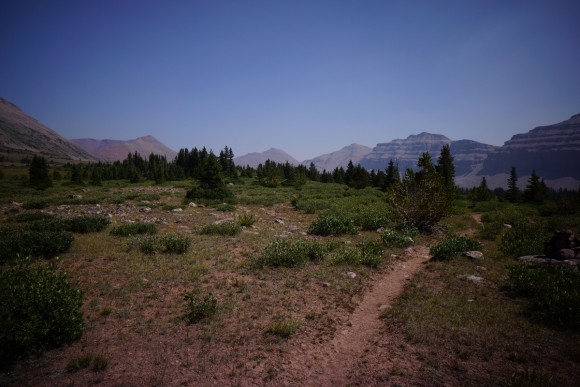
The trail was difficult to follow in some spots just past Squaw Pass. It just faded away at times. Although still an easy hike, it was more rolling hills now than the Upper Oweep Basin. That was really flat, and nice to be able to cover ground so fast. Now the basin really opens and mountain peaks dominate the horizon in all directions. This was one of my favorite stretches of non-pass, non-summit hiking of the trip through here. Too bad the haze was so thick, as the pictures didn’t come out great.
By now, after a few days of such great weather, I had been out in the sun quite a bit. I had been wearing my hat much of the time so my face and neck weren’t bad, but my arms, hands and calves were getting pretty red. I put some sunscreen on my hands and calves for the first time all week.
The trail gains about 200ft as it skirts the end of a ridgeline just before Lambert Lake, my intended campsite for the evening. Great views up here. There was a small lake on the way up that was beautiful. A little higher up along the trail there is a pretty good view of the entire basin. You could see the lake I just passed and everything else I hiked today all the way back to Red Castle Pass.
After rounding the edge of the ridgeline, I set off on the final push to camp. Lambert Lake is set off the trail a ways, but I figured there would be a pathway leading to it. I never saw anything like that and ended up walking a ways past it, and had to back track. Back at the trail, I just headed straight over to the lake. The view is nice when you first reach the lake, as the northern shoreline has cliffs about 40ft high. There did appear to be a campsite up here. However, I was thinking about having easier access to water, and headed down to check out the shoreline on the other sides of the lake.
I started out on the east side of the lake and walked clockwise around the lake looking for a campsite. I ended up choosing a spot on the northwest side of the lake, below the cliffs and in the trees. The really wasn’t much in the way of good looking campsites around the lake. Much of the shoreline was soggy, and the the water was shallow. Not exactly good for fishing. The east side was a little better in that respect.
It was a bout 3:45 now as I began to set up camp. With another day of clear blue skies, I decided to leave the tarp off above the hammock for now. If it looks like rain before bed I can throw it up. Otherwise, I’m sleeping under the stars tonight.
I was sitting on a log by the fire pit writing in my journal in the early evening when a man on horseback and his dog strolled into camp. The man says, “Sheep”? Ah, so he’s a sheep herder. I told him that I haven’t seen any sheep around here, not since Red Castle. He didn’t speak English at all and so we had some short one or two word exchanges before he kept moving. I should have offered him some of my food since I was going to have so much left. At least I wouldn’t have to carry it any more. But, I didn’t think of that until he was gone.
Next I walked along the shoreline underneath the cliffs to find an area where I could access the water a bit easier. Near camp it was soggy and no rocks to just sit on or put your gear on. Here I found a spot where I was able to get some water and wash up.
Back at camp I got a good fire going, in the best fire pit of any campsite I had in the Uintas. It was out of the wind mostly and had great seating around it. I was a little disappointed in Lambert Lake though. People were talking this place up like crazy but I didn’t think it was worthy of the hype. I would have rather camped either somewhere along the Highline Trail in Oweep Basin where it skirts the treeline or near that small lake at the end of the ridgeline I passed by nearing Lambert Lake, if I had a tent instead of hammock.
I crawled into bed under the stars tonight and hoped it would remain clear all night.
Day 8 – Thursday August 20th, 2015
Miles Hiked – 18.6
Route – Lambert Lake to East Fork Black’s Fork trailhead
Sleeping under the stars went off without a hitch. The weather remains clear although it was very windy last night. The cliffs above me blocked the wind almost completely though which was nice.
I left camp at 9am. From here I went up the boulders above me instead of walking around the lake again. After a short off trail hike I was back to the main trail. After a couple more good views of the mountains, the trails dips down into the forest for a while after passing Lambert Meadows.
After dropping about 600ft down the switchbacks the trail meets up with the Lake Fork River trail. Now, the trail is following Lake Fork River uphill towards Red Knob Pass. It was a nice walk through here but I was looking forward to the last pass of the trip… supposedly good views from here.
Just another mile to go until the base of Red Knob Pass. The pass starts out with switchbacks snaking their way up the mountainside. Not far ahead of me is a couple and their dog, whom I had been gaining ground on since they passed me during my break earlier.
The view from the top was awesome. Really, just incredible. The way Red Knob jets out into the valley like that. The 360° view of mountain peaks. The multitude of colors making up the mountains themselves. This was definitely one of the highlights of the hike.
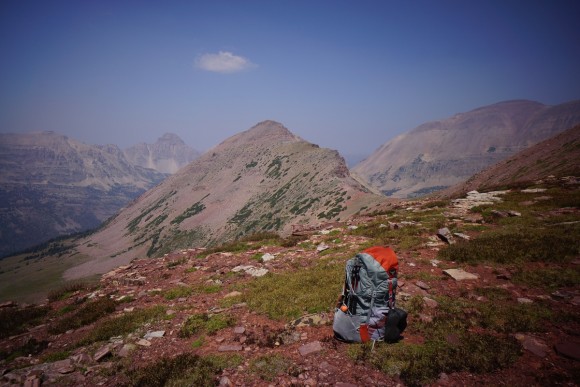
I was sharing the top here with the couple and their dog, so naturally we took turns taking photos of each other. Although I have my tripod this is much easier. We chatted for a while and they moved on, while I hung out and took more pictures. A sheep herder on horseback was also coming up over this pass while we were here. He dropped down into West Fork Black’s Fork basin towards Dead Horse Lake, and I went the other way, towards East Fork Black’s Fork.
The cool thing about Red Knob Pass is that it’s a ridge-walk as well, not just an up-and-over. Once you reach the “top” of the pass you still walk along the ridgeline a good ways to get to the area where the trail drops down into the next basin. I really enjoy hiking trails like this, high up on a ridge.
After making my way past peak 12248 the trail runs across the top of a saddle. Great pictures from here. You can see the backside of Red Knob, which actually has a pink look to it. Looking towards Wasatch Peak was really impressive. In the foreground, the rocks and soil are red and a greenish color. Closer to Wasatch Peak and beyond, it was pink and white. I can just imagine this scene at sunset.
Slowly I kept working my way along the trail, which was still up on Red Knob Pass. I had spent about an hour and a half up here taking pictures and taking it all in. By now it was time to head down and into East Fork Black’s Fork basin below. As I approached the top of the pass, the wind really picked up. More motivation to head down quicker.
Coming down the pass was not bad. Some switchbacks at the top then the trail follows a faint high point downhill through a large, open meadow.
I continued on until I saw the couple I was talking to up on Red Knob Pass hangout out alongside the trail. We ended up talking for a solid half hour. They were from Colorado and had done quite a bit of backpacking themselves. This was their 10th annual summer hike, compared to my 4th summer hiking out west. But great minds think alike! It was nice talking with such cool people out here for once.
It was 3:30 when I moved on. My plan was to grab a campsite high up in the basin, and hike the remainder out in the morning. However, I hiked a bit too far and dropped down into the forest. Here, the trail just went downhill through a bunch of downed trees. Not really where i had in mind for camping. I kept moving, figuring I’d find some decent campsites along the river further downstream.
There was one good spot along the trail that I stopped at for a minute. Honestly it was great, except not much protection from the wind. But really, I was just using that as an excuse to keep moving. I was really toying with the idea of just hauling ass back to the car tonight, and give myself a full day in Salt Lake City tomorrow. After all, I missed the opportunity to camp in the high basin, so I might as well just wrap it up tonight. Unless I find a badass campsite on the way back.
So, I kept moving with a renewed sense of purpose. I hadn’t eaten much now in the past few hours, but didn’t want to stop now since I was so close. I actually had a lot of ground to cover, and wanted to get back as soon as possible so I’d have daylight while driving on North Slope Road. At the speed I was moving, I could be back at the trailhead by 7pm.
I did find another campsite that would have worked, although probably better for a tent. It was right along the river in a very small patch of trees, but surrounded by a soggy field. I passed and kept moving. However, there were a lot of soggy, muddy fields along the way this afternoon. It became a challenge to find a dry way around, and many times just had to walk right through them. This was the only thing slowing me down at the moment.
I passed the remains of a small log cabin on the way. Further up, I passed a group of people headed out for a horseback ride. They had just seen a moose a ways back by another log cabin. Still no moose for me, but I did see some deer earlier.
I finally came to a water crossing that I was not able to hp rocks or walk logs across. I was getting pretty close now, probably 2 miles or less from the trailhead. I didn’t feel like taking the time to take off my shoes and socks, put on water shoes, cross, dry my feet off, put on the shoes and socks, etc. Instead, I just walked right through the water. Now water was sloshing out of my shoes with every step. However, I’ll be back to the trailhead in a half hour or so.
Now I came to the point where the trail from East fork and Little East Fork valleys comes together. From here on out, it was familiar territory, as I’d hiked this on day 1.
The trail was really rough the remainder of the way. Lots of rocks and the horses really tore up the ground. I passed a sign that was not posted when I came through here last week about an aggressive Goshawk nearby. A mile up the trail, I was back at the final bridge crossing at the trailhead.
It was about 6:45pm by the time I reached the car. I hiked close to 19 miles today, with about 9 of the being in the last 3 hours. I was a little out of it from pushing it so hard on the way down, but it felt great to be back at the car.
Now it was time for the drive out of the Uintas and back to SLC. I was on the road by around 7pm, and hoped to make it to the paved road (hwy 150) before dark. The road is extremely rough close to East Fork Black’s Fork, but gets better on FR-58 the closer you get to hwy 150. There was a lot of traffic on North Slope Road though. More ATVs than vehicles though.
I made it onto hwy 150 with 20 minutes of remaining daylight. South of North Slope Road, I saw 2 moose off the side of hwy 150. I wish I could have seen some while hiking.
The smoke in the air made for some great sunsets. I stopped on Hayden Pass to take a picture of the pink glow that lingered over the mountains, my final photo for the hike. Now, it’s time to play dodge the deer until I get to Kamas. There were tons of them in and alongside the road when I was driving through here on the way in.
It was a 2.5 hour drive from East Fork Black’s Fork before I had cell phone service, in Kamas. From here it was another 45 minutes to SLC. Once in Salt Lake City area, I stopped at a Wendy’s for triple cheeseburger combo meal and some chicken nuggets to give me some much needed calories. Finally, my appetite is back! I found a hotel in Sandy and headed there for the evening. It was around 1am before I finally hit the sheets. Long day. Another successful hike under the belt.
Final Thoughts
I really wanted to hike the Highline Trail from hwy 191 to Hayden Pass, which would have been about 95 miles as well. However, without assistance from another person involving a second car, this is not possible as a point-to-point hike. Therefore I was forced to modify my route. This allowed me to see Red Castle, which I would not have seen otherwise.
Highlights of the hike for me were King’s Peak, Red Castle and Red Knob Pass. King’s Peak was an easy climb with a kick ass view. No wonder there were so many people up there!
This was my first major hike with a hammock. Finding the right trees to hang from was a little tougher than I thought but was never a serious problem. I did have some fairly heavy storms for a while on the morning of day 4, and the tarp held up fine. It was a little nerve-racking though because it felt like a giant sail in the wind, and being a newbie to hammock camping, was not sure just how much this thing could withstand. Set up time improved greatly as I got better at tying the knots. Still, setting up and breaking down the tent is much faster. Regardless, the hammock beats the tent for comfort. It still doesn’t come close to my bed at home, but it beats the ground any day.
The whole idea of replacing my hammock’s spreader bars with my trekking poles suffered a serious setback. I’m really surprised the pole tips snapped off like that. My fault for not marking the trekking poles at the correct length. Now I get to buy another set of trekking poles. I’ll likely continue to seek the right poles for replacements to the spreader bars that come with the hammock. I just can’t ignore the weight savings. With trekking poles for spreader bars, the new hammock/tarp/over quilt/under quilt sleep system weighs half a pound less than my tent/sleeping bag/air mattress setup. Using the supplied spreader bars, I’d be adding a few ounces to my tent sleep system.
Physically, I did really well this year. I had no knee issues whatsoever. I think I can attribute that to my training regiment, which was something new for me… hiking! Prior hikes I would do stair climbs with a weighted pack for up to 45 minutes, a little running, and more leg exercises like squats and leg curls. Sometimes I’d have knee pain while hiking and sometimes I wouldn’t. Usually though, a 15 mile day would have me hobbling on my feet in camp at the end of the day. Not so this time. For training this time I hiked with a 45 pound backpack around a nearby river, a loop about 7 miles. Usually I’d do this in about 2 hours, sometimes more or less depending on the route variations I took. I did this 4-5 nights a week for 6 weeks. Tough to find the time after work, but I made time. I’m glad I did, because my knees, legs and feet all felt pretty good at the end of each day. This has eased some of my concerns as to my ability to do a thru hike someday.
As always, questions and comments are welcome!
If you found my trip report useful, please don’t hesitate to leave a comment! Alternatively, if you feel you have any information you’d like to share with others regarding this hike, please feel free to leave that below in a comment as well.
[tcb_comment_count]
Four Pass Loop – Maroon Bells Wilderness, CO Aug 2012 (Backpacking Trip Report)
Maroon Bells Wilderness, CO – Four Pass Loop Backpacking Overview
Complete Maroon Bells Wilderness Photo Gallery | Maroon Bells Wilderness HD Video
- Location – Maroon Bells Wilderness, CO
- Park – White River National Forest
- Trail Hiked – Four Pass Loop
- Miles Driven To Destination – 2980 miles Round trip
- Length Of Time Hiked – 6 days, 5 nights
- Trail Type – Loop
- Miles Hiked – 38 (includes summit of Snowmass Mountain)
- Trail Difficulty – 8/10
- Fires Allowed – Yes
Download a GPX file of my hike (right click and choose “save as”): Four Pass Loop – Maroon Bells Wilderness, CO
[sgpx gpx=”/wp-content/uploads/gpx/Maroon Bells Trip 2012.gpx”]
The Maroon Bells Wilderness caught my attention this spring when planning a backpacking trip during the month of May. I had read about the Four Pass Loop and after seeing some incredible pictures of this place, and I knew this was one hike I couldn’t pass up. There was too much snowfall on the ground still in May, and instead I hiked the Gila Wilderness in New Mexico. However, I would not have to wait long for my chance to hike here. I decided that the Four Pass Loop would be my destination of choice for my mid summer trip after my plans for Isle Royale fell through yet again. The plan was to hike the Loop, but camp an extra night at Snowmass Lake and summit Snowmass Mountain on the extra day. It would be a step above all my previous hikes in most aspects, especially elevation. Wikipedia has this to say regarding Altitude Sickness: “It is hard to determine who will be affected by altitude sickness, as there are no specific factors that correlate with a susceptibility to altitude sickness.”
The area we planned on hiking lies in the Elk Mountain Range in the Maroon Bells Wilderness, just outside of Aspen, CO. This is within the White River National Forest.
Prior to this trip, the highest elevation I’ve hiked t was 10,643ft (Black Mountain, Gila Wilderness, NM). This trip would raise that number by 3,455ft if I can summit Snowmass Mountain, 14,098ft. If not, the Four Pass Loop is comprised of four mountain passes between 12,400 and 12,500ft, so I’ll still surpass my highest elevation by more than 1,850ft anyways. I didn’t have a problem with the elevation in New Mexico this past May, but this was going to be the real test!
My girlfriend was coming with me on this trip. I was a little concerned with how she will handle the elevation, as well as the rigors of a big hike like this. She had gone with me on my trip to Manistee River last fall, a really easy hike, but that was her only prior backpacking experience. She was short some gear and had to buy rain pants, hiking boots, socks, sleeping bag, and a backpack. There was no way she could use my crappy High Sierra backpack I have as a “spare” for a trip like this. In fact, she used it last year at Manistee with maybe 20 pounds in it, and even that was uncomfortable. The only gear I had to buy for this trip was a few more OPsaks so the critters can’t smell our food. I didn’t even have to make a last minute trip to REI for something… nice.
Getting There
I won’t bore you with much details of driving here, it was pretty uneventful. Almost 1500 miles of farmland is enough to put anyone to sleep. We left Detroit on Saturday July 28th and drove about 15 hours before stopping in North Platte, Nebraska. We assumed that there would be plenty of hotel rooms available, but every hotel was pretty much booked. There were a few events going on, such as a soccer tournament. We had to settle for a smoking room at a Days Inn I think it was. It smelled awful, and apparently pets are welcome in the hotel because we heard dogs barking all night. It was pretty ghetto, but it was either this place or nothing since there were no other towns around.
The next day, we only had about 4 hours left to Denver where, where we planned on staying with Lisa’s friend. It was a pretty gradual rise in elevation the rest of the drive. We were relieved to finally see the Rockies about 30 miles outside of Denver. We arrived early in the afternoon, so we decided to grab a bite to eat and check out the Red Rocks area just outside of town. After that, we went to bed early and tried to get as much rest as possible before setting out on the final stretch tomorrow morning.
Day 1 – Monday July 30th, 2012
Miles Hiked – 4
Route – Maroon Creek Rd. Trailhead (West Maroon Portal Parking Lot) to camp along West Maroon Creek at 10,800ft
We left The Denver area around 5:45am today after spending the night at a friends apartment, which was about 4 hours from the trailhead in Aspen. After leaving Denver on I-70w, the drive was all mountains. It was a beautiful drive and really built up my anticipation for the hike. We stopped for breakfast at the Golden Burro in Leadville, which was pretty good. Their menus were full of history of the town, which included things like Doc Holiday’s last shootout. I recommend this place if you are passing through… good food, big portions, cool atmosphere.
After leaving Leadville, we passed over the Continental Divide at Independence Pass. We stopped here for a couple of pictures, but didn’t stay long. After this, the road really winds through the mountains, and offered some great views. It was a white knuckle drive though, thanks to the swarms of cyclists on the road. These guys were all over between Independence Pass and the Maroon Creed Rd. Trailhead in Aspen. They don’t move out of the way either, they ride in the middle of the road as if they are a car. I was ready to get out of the car by the time we reached Aspen, where I was picking up my fishing license I had ordered online. I was looking for “King Sooper’s”, which I thought was some type of gas station. There seem to be no visible addresses on buildings in Aspen, but I stopped where my GPS said the address was. We got out and walked around for a while trying to find it before figuring out that King Sooper’s was actually a grocery store called “City Market”. Apparently, it’s called King Sooper’s City Market, but how the hell would anyone know that from the sign outside that says “City Market”?
After grabbing the license, we dodged about a 1,000 more cyclists before reaching the entrance to the Maroon Bells Wilderness. We paid the $10 entrance fee and were told that the overnight parking lot was full and that we needed to park at the West Portal lot. This lot was packed with cars too, but we found a spot and began to gear up. I always bring a scale with me to the trailhead so I can weigh my pack right before the hike. Mine was 52+ pounds, Lisa’s was 34. Intersecting the parking lot was a trail that headed into the woods in the direction we wanted to go, but it was not clear where it was going. So, we hiked the pavement, following other hikers we saw leaving the parking lot. It was probably another 1/3 mile or so before we reached a bus loading/unloading area where they drop off hoards of day hikers shuttled in from somewhere. We weren’t sure where we needed to obtain the free permit needed to hike here, but after following the cement pathway we came to a small building that had some info on the wildlife and whatnot. There was another hiker in here filling out a permit, but there were none left on the counter and no park employees around. It was already around 11:30 and we couldn’t wait around for anyone to get us a permit, so I rummaged through the drawers on the other side of the counter and found a stack of permits, which I placed on the counter for everyone to use.
Finally, we were on our way. Today, we were going to hike about 4 miles and find camp somewhere near 10,800ft along West Maroon Creek. I had read that there were not many campsites past this mark, unless you plan on going over West Maroon Pass.
Maroon Lake is right there by the place we got the permit, with the Bells visible from the start. It was very beautiful but I was a little discouraged by the massive amounts of people in the area. I know that the trailhead area is always the most crowded, but I was having a hard time believing we were going to have any type of solitude here. However, many of these people had nothing on their backs and were clearly only here for the day, so we figured it would clear up after Crater Lake.
After leaving Maroon Lake, we hiked through a short wooded section before hiking a mile or so of rocky ups and downs leading to Crater Lake. The entire way here we encountered people coming or going every minute or two, and often much more frequently that that. Crater Lake was pretty dry, evidence of the drought this area has been experiencing. Only a week prior the fire ban was lifted for the White River National Forest, which was good news for us. Who doesn’t love a good campfire?
We should have scoped out the campsites near Crater Lake while we were here, since this was our intended campsite for night 5. However, since we were not making very good time today, we didn’t stay long. After passing the lake, we began to see less and less people, which was a good thing. Although we hadn’t hiked too far, it had been a while now since breakfast so we stopped for lunch at the base of a talus field below North Maroon Peak. Here, we caught our first glimpse of a Marmot. Lisa and I had never seen one, so watching them run around on the rocks was entertaining. We also saw our first Pika in this area, and saw our last person for the day… finally, some solitude!
After finishing up with lunch, we put our packs back on and immediately Lisa noticed a large water leak coming from her backpack. It was obviously the hydration bladder as this was the only item with water in it, but upon inspection we did not see any leaks or even a wet spot on the bladder itself. We were stumped as to where the leak came from, but my best guess is that the quick connect mechanism for the bladder’s tube had too much pressure on it causing the hose to be partially open. It’s just odd that there was no water in this area, nor was it wet. We kept our fingers crossed and hoped this would not happen again, and thankfully it didn’t.
Now late afternoon, it was pretty hot out at this point. We were both a little dehydrated, despite drinking tons of water in the morning and throughout our hike today. I had a bit of a headache, which I blamed on the elevation and dehydration. Lisa wasn’t feeling good, and was ready to stop. I wanted to make it to around 10,800ft today as I’ve read that there are not many good campsites past this mark. As we pushed on towards our destination, we encountered a few mountain goats grazing alongside the trail, maybe 30 feet away. I took a few pictures, and moved in closer to shoot a video of them. One of the goats turned and started trotting towards me, so I backed off and let them be. These guys were big, and I did not want to find out what they were capable of.
After leaving the goats behind, we crossed over to the East side of West Maroon Creek. I decided to start looking for a place to make camp for the night and dropped my pack to scout the area. We were just below the Len Shoemaker Ridge at this point. Leaving the trail and hiking up the hillside towards the ridge, I found a nice campsite on a hill with some good tree cover and a nice view. As we set up camp we could see several other mountain goats on the slopes South of Maroon Peak and above us near the Len Shoemaker Ridge. Great, hope these guys leave us alone!
Next, we headed back down to West Maroon Creek to filter some water. My MSR Miniworks water filter was usually good for 2-4 liters of water before needing to be cleaned, but the water was so clean here that I filtered 8 liters without the flow slowing down much. Of course, Giardia is still a threat no matter how clean the water looks and this water must be filtered or boiled in order to drink it. I chugged a liter of water while I was filtering, which I typically do in order to rehydrate and still leave with a full supply of water. After taking an asprin and downing that liter of water, my headache was gone.
Now it was time to hang our food. There are VERY few good places to hang food along the Four Pass Loop as most of the trees are coniferous and do not have long branches. My first attempt at a bear hang here ended up in the loss of my cordage, as it got tangled in the jagged branches of a leaning tree. I tried climbing this tree as well as the one next to it to get my rope back, but after a half hour I gave up. Fortunately I had a spare rope, but it wasn’t as long as it really needed to be. I brought a large dry sack to keep our food in, which was stored in my OPsaks. Being in the OPsaks, I didn’t worry too much about the quality of the hang as these bags seem to do an excellent job of masking the smell of it’s contents. I’ve never had a problem yet with animals getting into anything I have stored in these bags.
We ate our dinner in the talus field below the Len Shoemaker Ridge, about 200ft from our campsite. I happened to glance at our camp and noticed a large buck wandering around near our tent. So far, we had seen quite a bit of wildlife and this made us think what we were in for in the upcoming days. After finishing up with dinner we had a nice fire on the rocks below our camp and watched the stars for a while, before the brightness of the moon took over. We decided to call it a day around 10 or 10:30. Tomorrow is going to be a long day with two mountain passes to traverse.
Day 2 – Tuesday July 31st, 2012
Miles Hiked – 7.5
Route – Camp to Fravert Basin
I awoke on our second day to an awesome view of the unnamed peaks to the North. It was a relief to see daylight after a pretty uncomfortable night’s sleep. I felt great today, but my thermarest air mattress had a small leak in it that I thought I had patched up during my last trip to the Dolly Sods Wilderness of West Virginia. Apparently there was another leak somewhere as it was completely deflated. Then I checked my half-assed bear hang, which I was happy to see untouched. Being our first morning, and Lisa’s first hike since our trip to Manistee almost a year ago, we were pretty slow to break camp this morning. I also went down to the creek to top off our water supply which took an extra half hour. We have two mountain passes to climb today, West Maroon Pass and Frigid Air Pass, so I wanted to make sure we had enough water.
I think it was around 9am when we hit the trail today. After hiking about a half mile, we passed another group of hikers getting a slower start than us, still sitting around in camp. Around this point we began to see a ton of hikers going up West Maroon Pass, and I couldn’t figure where they all came from. Many of these people had nothing on their backs, so they were day hiking from somewhere, maybe their campsite nearby? Doubt they came all the way from the visitor’s center at this time of day. We probably passed 30 people going up to the top of this pass, way more than I was expecting.
We hiked in and out of small pockets of wooded areas, but it was mostly low brush. Wildflowers were pretty abundant here, we passed several varieties that got Lisa’s attention. After crossing West Maroon Creek again, we crossed a few more small streams before the landscape really began to open up. The view of the mountains surrounding us was incredible, even more so as we climbed higher. We couldn’t see the exact path of the trail leading up to West Maroon Pass until we were almost near the final 1/2 mile or so ascent.
Once at the top of West Maroon Pass (12,500ft), we were greeted by several other hikers. The first thing I did was pull of my boots and let my feet air out while we had the chance. It was noticeably colder and windier up here, but my feet needed to breathe. We ate lunch up here as well, and the chipmunks were already out investigating and begging for food. Obviously, they were pretty used to people, they were not afraid of us in the least. While I was sitting on a rock eating a sandwich, one crawled up my back! Crazy little bastards.
I also took this opportunity to pull out my Sony Nex-5 camera and take some pictures. Before I left for my hike in West Virgina in June, I ordered a bunch of camera equipment that didn’t arrive until after I got back, so this was my first trip that I had took with my new graduated neutral density filters, polarizer lens, etc. I set up the tripod and got a few decent pictures, but I still need to learn/practice more. Fortunately, the beauty of this place does most of the work for you, and there is no shortage of amazing things to photograph here!
Now on our way down West Maroon Pass and northwest towards Frigid Air Pass, the trail quickly gives way to a much gentler slope. It was really nice through here, just rolling green hills and meadows with tons of wildflowers. It was mostly downhill for quite a while, but not to the point where it’s hard on the knees. This was a relief after having just hiked 1700ft up the last pass. We only encountered one or two other hikers in this section before Frigid Air Pass, and played leapfrog with one of them for the last half of the section.
At the base of Frigid Air Pass, there was a dried up pond and a sign indicating the direction of the trail. This pass was much short in distance, but would turn out to be pretty damn steep near the top. Once over this, it was all downhill for the rest of the day.
At the top of Frigid Air Pass, we were again presented with unbelievable views, this time of the vast Fravert Basin. We decided to take a break up here before descending, so it was time again to air out the feet and have a snack.
We saw at least 3 marmots up here and this time I was able to get a few good pictures of one up close. Camp for the night was going to be somewhere down in the Fravert Basin, wherever we find a decent site. However, the clouds were really starting to move in, and we weren’t sure exactly how far we’d have to go until we find a good spot. We this in mind, we cut our break short and descended into the basin as quickly as possible. After all, it was late afternoon now, and I’d hoped to be at camp already.
We made great time getting down from the pass, and before we knew it we had made it to the forested area near the bottom. I knew there was a river down here and somewhere near it was going to be our best bet for a campsite. Once we got close enough to actually see the river, I left the trail and began to look for potential campsites. I didn’t see any previously used ones, but found a descent site on the opposite bank of the river. It was a tall grassy area situated a few hundred feet from the bank, forming a clearing around 30′ in diameter. I wasn’t too pleased with the site myself, but we we tired and the weather was looking pretty nasty.
The good news about this site was that the ground beneath us was pretty soft, so we should sleep good tonight. Well, as good as you can with a deflated air mattress. It was also much closer to a water source than our site last night, which was a huge bonus. On the downside, there was nowhere to hang food here, not one tree. I climbed up the rocky hillside above our campsite and found a dead tree trunk on which I set our food bag. I didn’t like the idea of letting it sit out like that, but here was nowhere to hang the food near our site. I felt pretty confident that the OPsaks would do their job, and those were stuffed inside the dry sack, so I didn’t feel too bad about it.
As it got dark, it began to sprinkle a little bit on and off. The rain wasn’t a worry, but the winds were picking up and lightning was flashing all around us. At one point we saw a bolt strike the unnamed 13’er that towered above our campsite. This was the nearest peak and had us a little worried, but after an hour or two the weather calmed down and we were finally able to get some rest.
Day 3 – Wednesday August 1st, 2012
Miles Hiked – 9
Route – Fravert Basin to Snowmass Lake
I woke up around 6am today, determined to get an earlier start than the day before. It was very cold this morning, and everything was wet from the rain last night. Fortunately, all of our gear stayed dry and our food bag was untouched once again. I headed down to the creek to top of our water while Lisa packed up the gear inside the tent. This became our morning routine… I took care of the outside stuff like the bear hang & filtering water while she rolled up the sleeping bags, the air mattresses, etc. I took some of Lisa’s weight when were packing our backpacks so that today might be easier for her. I would have taken more, but there’s only so much room in my pack! After eating a met-rx bar and whole wheat bagel for breakfast, we were on the trail today by roughly 8am.
As soon as we we back on the trail, we passed several campsites. I knew we had to be close yesterday, but you never know… could have hiked another mile or two before finding a suitable site. We also passed several hikers in the first hour of today’s hike. After about an hour, the trail leads you to a nice overlook of a river in the valley below. A waterfall can also been seen just off the trail. I tried to take some pictures up here, but the lighting wasn’t the greatest at this time of day. Lisa went ahead of me while I took some pictures, and when I was done I caught up with her. After a sharp decent of a couple hundred feet, we were on the valley floor.
Now looking back up to our overlook spot above, I was tempted to try and get some pictures of that waterfall. this would require a short off trail hike, maybe 1/2 mile. Lisa didn’t want to go, so she stayed behind as I worked my way towards the falls. The vegetation was still covered with last night’s rain, and soon I was too. The route I chose to the falls was much thicker than I thought, but I eventually made it. I took a few quick pictures before heading back. Lisa was waiting for me so I didn’t want to stay too long. Instead of working my way through the woods again, I opted to follow the waterfall down. It was very rocky but it looked like there was less vegetation on the rocks and this offered a glimmer of hope for not becoming completely soaked. However, even here existed thick shrubs that had me drenched by the time I made it to the bottom. Lisa was glad she didn’t go when she saw me!
The next section was fairly flat and wandered though a pine forest with a ton of downed trees before hugging the North Fork Crystal River. There were a few nice campsites through here that I really would have loved to have stayed at had we hiked this far yesterday. This was a really peaceful hike… didn’t see a soul and it wasn’t too difficult. It seemed like we covered some good ground too.
After crossing the North Fork Crystal River, the trail remained somewhat flat for another mile or so before steep switchbacks led the way to Trail Rider Pass. I think we both agreed that this was the longest and most difficult pass of the trip. Now in direct sunlight, I put on my hat so I didn’t get to burnt. Lisa didn’t have a hat though, and was getting quite red even with the application of sunscreen. The views of Lead King Basin were incredible though!
The entire way up, we couldn’t really see where Trail Rider Pass was exactly. After a short climb to the top of the hill above the Geneva Lake Trail intersection, we reached a bit of a plateau. There was a small lake up here, and this made me think how awesome it would be to camp up here. However, this didn’t fit with our plans, and knowing that Snowmass Lake is on the other side of the pass I quickly forgot about the idea. From here, we could finally see where the trail was heading. It seemed like a really long way to go still, especially after the long hike up to where we were now.
The “plateau” was a nice break from the steep inclines, but soon the path up Trail Rider Pass became just as steep as any of the passes before it. Once again, I was blown away at the view! Snowmass Lake looked incredible, and we couldn’t wait to get down to it. This was the only pass that we did not share with any other hikers, which was nice. It was very cold and windy up here, even after sweating our way up to the top. We hung out up here for about 45 minutes to air out our feet, eat, and take pictures before heading down.
The trail was very visible on the mountainside, and it could be seen for quite a ways here. Some of the gullies still had snow in them, and this was the closest we’d come to them yet. Once we got our first view of Snowmass Mountain, I pointed it out to Lisa. Although we had planned on climbing it together, after seeing it first hand, she decided against it. This was somewhat of a relief to hear because I had a feeling this was a little more than she could handle. I have to admit that I was having second thoughts as well, since I had never climbed anything like this before. Not even close. But, I had my mind set on it and that was that.
We made great time hiking through this next section as we were both pretty eager to get to camp. There were some cool views of the lake as we emerged from small patches of wooded areas. The water was an incredibly vibrant turquoise blueish color that seemed to change every time we looked at it. It didn’t seem like Snowmass Lake was too far, but the hike ended up taking much longer than I thought. I wasn’t exactly sure where the campsites were located along the lake, and I assumed they were scattered along all sides. However, the trail took us to the far end of the lake and past it. Now, I wasn’t sure if we had missed a trail leading to the lake. Eventually we crossed the river and the trail headed up towards the lake again. While there must have been a shorter route, the way we ended up hiking seemed like it added another 45 minutes by the time we passed the lake and had to hike uphill again to get to the campsites. Just before the lake were two good sized waterfalls, and pools filled with Brook Trout. We passed a few guys who had caught some, which I hoped to do tomorrow!
Once we reached Snowmass Lake, we were surprised to see how many people there were here. Of course, all of the good campsites were taken now that it was 6:30pm. We settled on a less than prime campsite, which was disappointing knowing that we were spending 2 nights here. We could always move sites tomorrow when others clear out, but is it really worth the time and effort? I’ll be climbing Snowmass Mountain tomorrow, so will I want to move when I get back? Probably not. The site wasn’t all bad though. Being set a little farther back from the lake, it seemed like it offered more privacy than some of the other sites. And, people weren’t walking past our site every 2 minutes since it was off the main path. However, there are no campfires allowed within 1/2 mile of Snowmass Lake, which was another disappointment. There were signs posted warning of a $325 fine for having a fire!
Despite being in a wooded area, there is nowhere good to hang food near the lake. My bear hang ended up being maybe 5 feet off the ground, suspended in between 2 trees that were about 12 feet apart. Not ideal, but better than nothing. I saw many others with half-assed bear hangs as well. After setting up camp and finding a bear hang location, we headed down to the river to filter some water and take pictures. There were no colors on the mountains tonight to reflect in the water as I have seen in some pictures online, but I have one more sunset and 2 sunrises still to look forward to here! It sprinkled on and off for the rest of the night, but not hard enough to keep people out of their tents.
Back at camp, I packed my Camelbak for tomorrow’s climb. I had debated on the necessity of bringing the Camelbak, but knew it would be perfect for my climb and was worth the extra weight in my pack. I figured 2 liters of water would be enough, stored in my Osprey bladder. I packed my map, compass, gps, first aid kit, food, and camera equipment. I took out some moleskin so that it was ready for me to put on in the morning to cover the blisters on the back of my heels, which fortunately were not hurting too bad. Packed and ready for tomorrow, I was in bed by 10pm.
Day 4- Thursday August 2nd, 2012
Miles Hiked – 5.7
Route – Summit Snowmass Mountain, same campsite
To be honest, I didn’t sleep much last night. I was pretty nervous about climbing my first 14er, and doing it solo. Sleeping on a deflated air mattress also doesn’t help either. When my alarm went off at 5am, I was having a hard time getting myself up to do this, but after a few minutes I got up and moving. The weather was clear, and I could still see the stars quite well. I retrieved our food from the bear hang, ate some breakfast and packed my lunch into the Camelbak.
I left camp around 5:30-5:45am and began the hike around the lake. This was actually one of the worst parts about the entire climb! The trail was cut through thick vegetation that one could not help but to brush up against, which was still wet. It winds along the lake, sometimes on the shore and sometimes on the hillside. There were many roots sticking up that you either trip over or slip on. After 10 minutes, I was soaked to the bone. My boots were full of water, and at this point I felt like it would have been easier to walk through the lake itself! Near the other side of the lake now, I found it easier to follow the very narrow shoreline of the lake instead of the trail itself. In doing so, I missed where the trail went and I ended up scouring the shore for a route inwards toward the base of the scree field, unsuccessfully. Blocking my path was some very thick vegetation, a stream, and some very soft ground. I had to turn back and find the trail. I saw another group of climbers making their way around the lake as well, so I watched where they went and took the same route out onto the scree field.
There were 2 climbers already working their way up the scree field when I passed another group of 5 stopped at the bottom putting on their helmets and checking their gear. I was able to follow the path of the 2 climbers above me through the scree field, which was not as bad as many people had made it out to be. It was steep and loose in spots, but I was expecting worse. The steepest section of the scree field was near the top, below the grassy area.
Now on the grass, I passed the 2 climbers that were above me. We stopped briefly to chat, discussing routes up the mountain. I was planning on doing the typical over-the-ridge route, but now that I was up here I was thinking about the shorter route that people take when there is no snow. I opted for the shorter route, while the other 2 hikers were going to ascend via the standard route.
It was nice to be off that scree field. The grassy area was a nice break, although still a climb. There were many small streams of water flowing through this area, with lots of large boulders dotting the landscape. I made pretty good time going up through this section as it gave way to larger boulders. Now you must hop from rock to rock, and sometimes climb from one to another. Some tilt, move, or shift when you step on them, so being conscious of where you step is crucial. The entire way up, I could hear rocks falling in the distance from Snowmass Peak (not Snowmass Mountain).
Once I got close enough to the top of the ridge to see some detail, I could see that it was pretty damn steep. It got steeper and steeper towards the top, until the last 20 feet or so became almost vertical. This climb definitely had some exposure. Although a fall from this height isn’t likely to be fatal, the terrain below was very steep and rocky. You would certainly tumble down the mountainside along with a ton of rocks, which could easily be lethal. So, I hesitated for a few minutes before attempting this climb. After all, I was by myself, and If I get hurt, who would even know?
My adrenaline was pumping like crazy as I started climbing. The handholds on the rock face were good, but extremely crumbly. Even large handholds would just fall right off, so it was vital to test each hold before committing to it. I made the mistake of looking down once, which made me a little dizzy. I turned around and calmed myself down by concentrating on what’s above me and not thinking about what’s below. This worked well and I made it to the top of the ridge. I was a little shaken, so I stopped here for 10 minutes to plan my final ascent to the top and regain my composure. This was the scariest part of the entire climb for me.
The final ascent along the backside of the ridge looked daunting when I first saw it, but once you start moving you can start to see the lines. There are some cairns here and there, follow them when you see them. The summit itself is hidden for most of the ascent and only visible near the top.
Even at 14k feet, I didn’t feel like it was difficult breathing. I felt perfectly fine, and did not feel any shortness of breath whatsoever. I was really surprised at this, but certainly not complaining. This made me wonder how high I’d have to climb before experiencing any breathing problems. I had never been this high up in elevation, so it was nice to know what my body is capable of for future trips.
I made it to the summit of Snowmass Mountain around 9:30am. My GPS said 14,061ft but I am going to trust the folks at the USGS over Garmin and go with the 14,098ft figure they claim. The weather was surprisingly calm and not too windy, but it was turning cloudy fast. The view was so incredible, I just wish the skies were blue for my pictures and it would have been perfect! Views of the red colors on the mountains contrasting against the greens were especially beautiful, never seen anything like that. I could see Geneva Lake below, which would have been a nice place to camp had I planned my trip to include a night there. Maybe on a trip in the future? I could see myself coming back here!
About 15 minutes after I reached the top, the 2 climbers I passed earlier had joined me. I was taking pictures at this point, and we exchanged some of each other before moving on to our lunches. We chatted and ate for about 45 minutes before heading down around 10:30am.

The other 2 climbers descending Snowmass Mountain. This is just over the ridge, along the standard route
I didn’t want to down climb that death wall I climbed up earlier to get over the ridge, so I decided to take the longer route that the other climbers had taken. I missed the route up over the ridge going this way and had to backtrack a little to find it, but I was over the ridge by 11am. The next few hundred feet of my descent involved climbing down and jumping from rock to rock, which were surprisingly stable. Once I got the hang of moving on these large boulders near the top, I was flying downhill at a good pace. Before I knew it, I could no longer see the other 2 climbers, who went over the ridge at the same time as I did.
Now at the top of the scree field, I was searching for the route I took up but didn’t see it. The route I ended up taking put me in the scree field higher up than the way I ascended, and this meant steeper terrain and more time in the gully. Parts of this gully had water flowing down it, and it was pretty slippery. At one point I slipped and fell on my ass, and slid about 5 feet down before stopping myself. I’m just glad I didn’t pick up any real speed. Going down the rest of the scree field wasn’t too bad though. The easiest way to move here was to walk downhill “sideways”, and slide down the rocks in a controlled manner.
Near the very bottom of the scree field, I was crossing over a small stream when I slipped on some roots and fell on a boulder, right on my hip. This fall hurt but I was ok. Later on, this would turn into a softball sized bruise. Going around Snowmass Lake was still a pain in the ass, even now that it was mostly dry. I fell once or twice making my way around the lake. It’s funny that the the most treacherous part of the climb wasn’t even up on the mountain!
I made it back to camp early afternoon, around 1pm. Just then, it started sprinkling. What great timing, I thought. I had neglected to bring any rain gear with me since it wouldn’t fit in my Camelbak, which in hindsight was probably a mistake on my part. Especially since I could have used it in the morning when traveling around the perimeter of the lake. My first priority was removing my boots and getting some air to my feet, and secondly, chugging some water. I had only drank about 1.5 liters of water during the climb, as well as a full liter in the morning before leaving camp. I wasn’t feeling dehydrated, but my pee was pretty yellow.
While I was gone climbing, Lisa took a few pictures with the Canon Powershot:
After getting my fill of h20 and filtering more water, I had the rest of the day to relax. Lisa was happy to sleep in and use today as a recuperation day, and had a very laid back morning by the lake. We thought about moving camp to a better site, but decided that it didn’t matter and the time spent moving would be better used fishing, exploring, etc. We headed down to the lake shore, and hung out here for a while taking pictures and getting some sun. It was pretty hot when it wasn’t cloudy, but pretty cool otherwise. Lisa and I laid out on a large rock at the edge of the shore for a while before trying my hand at fishing. I didn’t bring much for gear, and other than a Mepps spinner and a spoon I didn’t have anything for trout. I completely forgot to pick up some worms when we stopped for my fishing license in Aspen. Needless to say, I didn’t catch anything in the lake. Back by the mouth of the river, we saw a mink or weasel, not sure exactly. It appeared to have a mouse in it’s mouth as it scurried along a log protruding into the water.
I also fished the pool below the 2nd waterfall on Snowmass Creek, heading away from the Lake. I could see several trout in here, maybe 15 or so. There were a few that were 10″ plus, but they didn’t want anything to do with my tackle. After a few snags and no bites, I gave up. I wouldn’t have been able to eat them anyways, since I left my stove behind for this trip and opted for easier to prepare food, and there are no fires allowed by the lake. So either way, it was going to be catch and release.
Closer to sundown, I set up my camera equipment in hopes of capturing some colors on Snowmass Peak reflecting in the lake. There were no colors yet again, but it was still very picturesque! We pigged out on some sour patch kids as the sun went down. Without being able to have a fire, there wasn’t much else to do but go to sleep. We did hear a coyote howl shortly after lying down though. After it’s 2nd or third howl, someone camping near the lake did his own coyote call to mock it. I could have gone without that.
Day 5 – Friday August 3rd, 2012
Miles Hiked – 5.6
Route – Snowmass Lake to Minnehaha Gulch campsite
My alarm went off at 6:15 today. I wanted to catch the sunrise and hopefully capture some great photos. The water was like glass and so far the sky was completely clear. Absolutely perfect conditions! I set up the tripod and got my camera ready while Lisa filtered water. We hung out here for quite a while taking pictures, eating, and just taking in the beauty of this place before we hit the trail at 9:15.
The hike back to the main trail seemed much longer than I remembered. Maybe 20 minutes after leaving camp, we passed a large pile of boulders that housed a family of marmots. These guys were all over the place… I wasn’t expecting to see so many! Finally back on the main trail and heading towards Buckskin Pass, we only passed a handful of hikers, mostly closer to Snowmass Lake.
Today’s hike had us traveling through more forests than the other days it seemed. I was surprised to find out how wide open everything is here, I wasn’t expecting to have huge views almost every step of the way. That’s how it is here though… huge, spanning views everywhere. Seldomly did we find ourselves in a forest area for more than a few hundred feet at a time. Being in the shade was a welcome feeling, especially for Lisa who had gotten quite a bit of sun by this point.
After crossing Snowmass Creek late in the morning, we saw a beaver dam. We saw the “lodge” off in the distance, but no beavers. A waterfall lies downstream of the dam, but I didn’t stop to explore. The trail follows the creek a short ways before splitting off in a V. The funny thing is that in between the fork lies a tree with a sign on it that just says “Trail” and doesn’t point in either direction. It’s placement in the fork doesn’t indicate which direction to go, so the sign is completely useless! I chose the one that went up, and apparently I chose wisely.
The trail worked it’s way up the mountainside for a while before emerging from the tress and once again exposing us to intense sunlight for the ascent of our final mountain pass. On the bright side, Buckskin Pass was probably the easiest one of the four, at least in the clockwise direction we hiked it.
We saw several more pikas and marmots on the way up. The marmots had burrowed into parts of the trail, leaving large holes in places. We still couldn’t see where the trail was taking us, or where exactly the pass itself was. By the time we could see where the trail was taking us, we were almost at the top. It didn’t seem as long or steep as the other passes, and we made it to the top by midday.
Of course, there were several other hikers up here already. We ate lunch and chatted with a woman who was by herself. She told us that a climber had died on North Maroon Peak the week before. This made me feel glad to have returned from my solo climb unscathed. Very sad to hear though. We saw a man descending Buckskin Mountain as we sat eating lunch, who eventually came over our way. I asked him about his climb and he on his way rather quickly.
The cool thing about this view from Buckskin Pass is the different perspective you get of Snowmass Mountain and Snowmass Peak. From Snowmass Lake, Peak looks taller than Mountain. But from here, you can clearly see that Snowmass Mountain is taller. North Maroon Peak can be seen to the south and Pyramid Peak dominates the landscape to the southeast.
The east side of Buckskin Pass was much steeper, thankfully we were going down it. The weather was threatening to rain on and off like always, so we were trying to hurry up and get to our intended campsite at Crater Lake asap. However, after descending about 1300ft we camp across a campsite that had a pretty badass view, and was only a few hundred feet from a small stream. I knew Crater Lake was going to have a ton of people, and if you haven’t guessed yet, I like my solitude. Tomorrow’s hike was only going to be 2 miles back to the car, so adding 2 more miles of downhill hiking wasn’t really an issue. This is it, our final campsite of the trip.
It was 3pm when we stopped for the day, which was our earliest time yet. It sprinkled briefly as we set up the tent. While we were setting up camp, a group of 3 or 4 people passed by on horseback, with about 10 horses total. We had seen piles of horse shit here and there, but this was the first time we’d actually seen people on horseback. This site had a rope tied between 2 trees about 15 feet up, so this was the easiest bear hang of the whole trip. We really wanted a fire tonight since we only had one on our first night. We gathered some wood and stored it under the base of a pine tree to keep the wood dry, just in case it rains. We filtered water from the creek, which would be enough for tonight and tomorrow since it’s an easy hike back to the car. Filtering water always seems like it takes a long time, but as clean as the water was here in the Maroon Bells Wilderness, it went a lot faster not having to stop every other liter to clean the filter.
Back at camp, we were sitting around on a log when an overly territorial bird started messing with us. We later found that it was a Grey Jay. Just as it did in a previous campsite, the bird would circle us, hopping or flying 10 feet or so at a time. It would look at us for a few seconds before moving to another position. After making a complete circle, the bird stood on a stump facing away from us. It then proceeded to do a 180, stared at us for a few seconds, then flew directly at us! It turned away only 6 feet from our heads. We must have been near it’s nest or something, but I had never seen a bird act like that. It was pretty comical!
Sometime later, the thong piece on my sandal had come off and it was now almost impossible to walk in them. The thong had separated from the foam body of the sandal, taking with it a chunk of the foam. I sliced a narrow hole through the body of the sandal underneath the area of foam that was missing, just large enough to force the foam chunk attached to the thong through. I was skeptical of the longevity of this solution, but it felt great and was still intact by the end of our trip. Good fix, but now I’m in the market for another pair of sandals before my next trip.
Our campsite offered excellent views of Pyramid Peak, Sleeping Sexton, and North Maroon Peak. We spent most of the evening lounging around, just enjoying the view. Below our campsite, it was evident that an avalanche had been through this area at some point. All of the trees were uprooted and a path was cleared through the forest. We didn’t get a direct view of the sunset, but there were some cool colors going on in the sky behind Pyramid Peak. It was actually fairly dark when all of the sudden the sun, which was behind Buckskin Pass somewhere, started shining on the clouds behind Pyramid Peak somehow. This seemed to defy all logic, but gave us a 5 minute window of some beautiful reds and oranges before finally going down for the night.
The stars came out very bright tonight as it was mostly clear. However, the moon was almost full and drowned out the stars by around 10pm. I was really hoping to see the night sky with great clarity on this trip, but between the weather and moonlight, that never happened. Being from the city, I don’t get to see very much of the night sky, so I always look forward to it when I go backpacking. Next time, I might try to plan a trip concurrent with the phases of the moon for best results. We stared at our campfire for a little while longer before calling it a day.
Day 6 – Saturday August 4th, 2012
Miles Hiked – 4.2
Route – Camp to car
This morning I awoke at 6:30 with the hopes of viewing the sunrise, but again there was no direct line of sight as it rose behind a ridge blocking my view. I’m sure the Maroon Bells would have looked spectacular this morning viewed from Crater Lake, but I was not regretting my decision to avoid the crowds. The weather was cool and clear as it was every morning here, and looked like a gorgeous day. As beautiful as it was here, we were ready to go back to the car and have a taste of civilization. We packed up camp and were en route back to the trailhead by 9:15am.
After leaving camp we hiked through the avalanche area that we overlooked yesterday. It’s pretty amazing to think that snow can literally wipe out everything in it’s path like this. The rest of the hike to Crater Lake was downhill from here, and mostly covered by trees once we passed the avalanche zone.
Once we neared Crater Lake, you could see how dried up it was from above. This must be a far cry from last year, which I was told had near record snowfall, so I’m sure the water level was much higher then. There weren’t any other people around yet, but that’s because it was still a little too early. After leaving Crater Lake, we were once again confronted with an army of day hikers. They come in by the busload at the visitor’s center, and seem to hike no farther than Crater Lake for the most part.
It seemed that the trail in between Crater and Maroon Lakes was much shorter this time around. Our large packs gave us away to the day hikers, who frequently stopped us to ask about our trip. I don’t mind stopping to chat, but after 6 days, we were ready to get back to the car, with a shower as our ultimate goal for the day. That, and a hot meal.
By the time we reached Maroon Lake, the day hikers were out in full force. We stopped for a minute at the lake for few final pictures. I couldn’t help but look back at the Maroon Bells and reflect upon the most amazing backpacking trip of my life.
The hike back to the car seemed much longer from here though, despite being downhill this time. We made it back to the car around 11am, just in time to avoid the heat of the day. It felt great to finally change into shorts and sandals, and to sit on a comfortable seat instead of a log.
On the drive through Aspen, there were even more cyclists than I remember. We passed over a small bridge that had so many bikers that they had to get off their bikes and walk them across. There must have been 50 bikers on a bridge that was only 100 feet long! It was a biker traffic jam, pretty ridiculous if you ask me. There also seems to be a shortage of gas stations in this town. The ONE we stopped at was cleaning it’s bathroom so we had to look elsewhere. We ended up going to the King Sooper’s “City Market” grocery store again. I saw a few bikers almost get clobbered by cars backing out of parking spaces, and I almost hit a few myself. This place is a nightmare with all the pedestrians!
I was relieved to be out of Aspen, but we weren’t out of the woods yet. There were still tons of cyclists on the narrow mountain roads going all the way up to Independence Pass. After going over the pass they seemed to disappear from the roads and I felt much more comfortable driving.
We stopped in Leadville again for some food, and there was some sort of festival going on. We parked a few blocks off the main strip and headed towards a cool looking place called the Silver Dollar Saloon. The place was packed because of the festival, but a busboy showed us to a seat right away. The atmosphere was very cool in here, very old looking with lots of cool artifacts on the walls. There were several guys in here with handlebar mustaches, cowboy hats, and had pistols holstered on their side. We sat there for about 20 minutes and didn’t see ONE waitress anywhere in the entire restaurant. The only employees we saw were the busboy and one bartender, and nobody came by to give us a menu or take our drink order. We left and went to another place down the street called the Pasttime Bar. We were served immediately here, despite them being very busy as well. The food was great and the service was so-so.
We got back to the Denver area by late afternoon and immediately jumped in the shower. Finally, the moment I had been waiting for! After getting clean, we headed to downtown Denver for dinner before going to bed around 10pm. Tomorrow we would drive straight through to Detroit, but for now, it was time to get some good sleep on a real bed.
Final Thoughts
The Maroon Bells Wilderness is absolutely beautiful! This was easily the best hike of my life, no questions about it. This is the trip that all others will be measured against in the future. On top of the non-stop postcard perfect views, abundant wildlife, and sense of real adventure, the weather was pretty damn good. We didn’t get rained on once during our hike, only light rain at camp and slightly heavier rain our second night. No injuries, no altitude sickness beyond a bit of acclimation woes our first day, and overall just a smooth trip. Everything went according to plan, which is always a great feeling.
The downside is that there were a lot of people hiking here, which takes away from the whole experience in my opinion. At this time of the year though, crowds are to be expected, so I wasn’t holding out hope for a whole lot of solitude. Still, there were many more people than I had anticipated.
Climbing my first 14er, and doing it by myself was a huge thing for me. Just a great feeling that I really can’t describe. So glad I did it and hoping to do another someday soon!
I was disappointed with the fishing aspect of the trip, which is becoming the norm for me unfortunately. I don’t pick my trips with fishing as the main goal though, so when it doesn’t pan out it’s not too big of a deal. I didn’t get to see the stars like I’d hoped, nor was I able to photograph any good sunrises or sunsets. You can’t win them all though, and I still got some great pictures.
Complete Maroon Bells Photo Gallery
As always, questions and comments are welcome!
If you found my trip report useful, please don’t hesitate to leave a comment! Alternatively, if you feel you have any information you’d like to share with others regarding this hike, please feel free to leave that below in a comment as well.
[tcb_comment_count]


